This demo shows how to automate customer interactions using APIs and Integrations. To put this in a context of a business it is based on a car repair scenario. Most likely this is not an exact scenario for your client. It is up to you to make the linkage to your customer’s needs to support their customers.
All businesses have customers. Governments support citizens, B2B businesses have upstream and downstream businesses they deal with and most obviously B2C businesses have customers who need support. The demo works through a series of steps to: obtain and validate input information from a customer with a concern, open a case in Salesforce, attach the incoming information to the case, analyze the tone of the situation, and respond to the customer with the case number and expected date for resolution. This should be applicable to almost every business. Do the planning to understand your customer’s customer and what type of interactions they might have that fit this pattern.
This Demo Script has multiple tasks, that each have multiple steps. In each step you have the details about what you need to do (Actions) and what you can say delivering this demo step (Talking Points). The Demo Talking Points are a suggestion, but you are welcome to customize based on your sales opportunity. Most importantly practice this demo in advance. If the demo seems easy for you to execute the customer will notice this. If it seems difficult for you to execute the customer will notice this as well.
IMPORTANT NOTE: YOU ARE USING A SHARED DEMO ENVIRONMENT, PLEASE DON’T CREATE CUSTOM FLOWS OR APIS IN THIS ENVIRONMENT. DON’T DO ANY CUSTOMIZATION (INCLUDING CUSTOMER NAMES). MULTIPLE SELLERS ARE USING THIS ENVIRONMENT AT THE SAME TIME. PLEASE JUST FOLLOW THE SCRIPT. IF YOU NEED TO DO A CUSTOM DEMO, PLEASE VISIT THE DELIVER PAGE AND SELECT 300 DEMO OPTION.
0.0 - Demo Introduction
| Demo Introduction | |
|---|
| Actions | Show Demo Introduction Slides. |
| Talking Points | Automating customer interactions can provide the difference between a satisfied customer who wants to do more business with you or a disappointed customer who is looking for an alternative option. In addition, it can remove manual steps, data entry into multiple different applications, and potential errors and delays – all of which are additional costs to your business. This demo automates a series of steps to: obtain and validate input information from a customer with a concern, open a case in Salesforce, attach the incoming information to the case, analyze the tone of the situation, and respond to the customer with the case number and expected date for resolution.
To automate this customer interaction, we will use both APIs and integrations to back-end applications. The demo scenario is related to a car repair, but this is just an example. The same techniques are applicable to your environment in support of your customers.
In the demo we will execute the following steps:- Access the Cloud Pak for Integration environment and explore the capabilities
- Review the automated customer interactions integration flow
- Manage access to the flow as an API and set up the security and rate limits
- Demonstrate how a developer can use the API Portal to perform self-service consumption of the API
Let’s get started! |
| Screenshots |
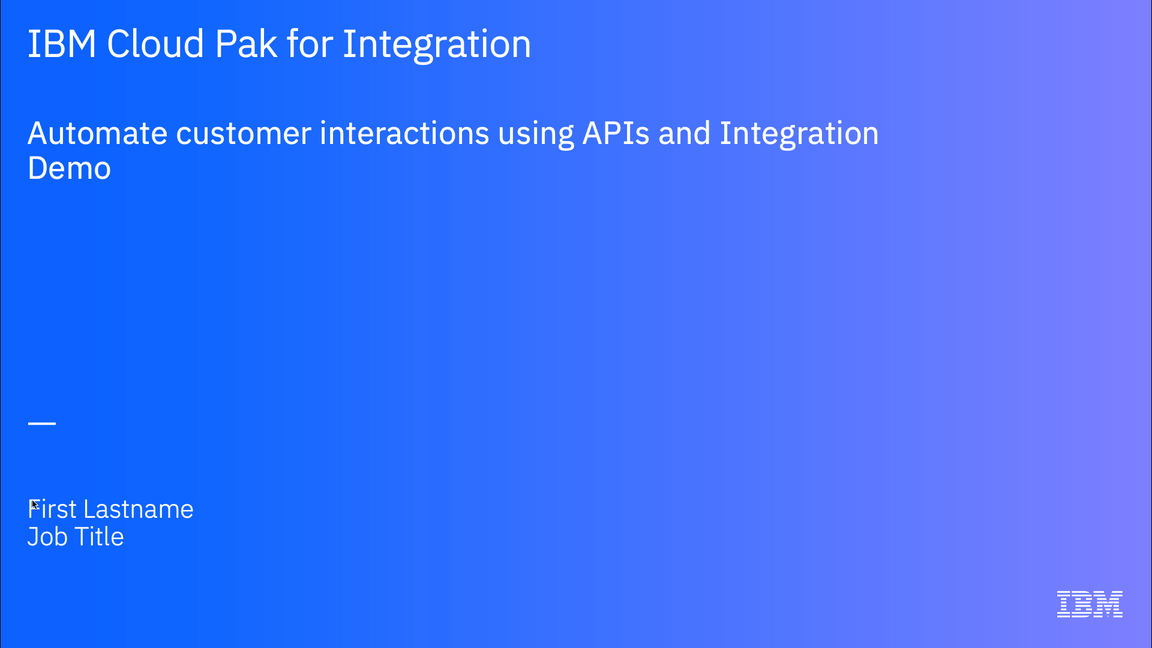
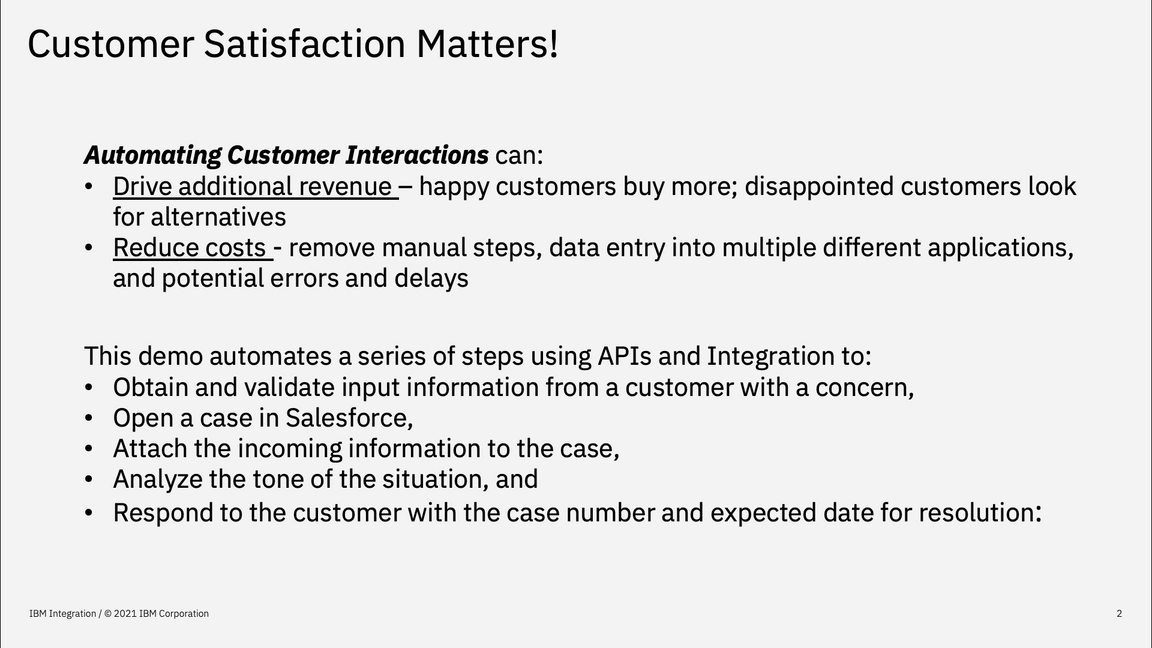
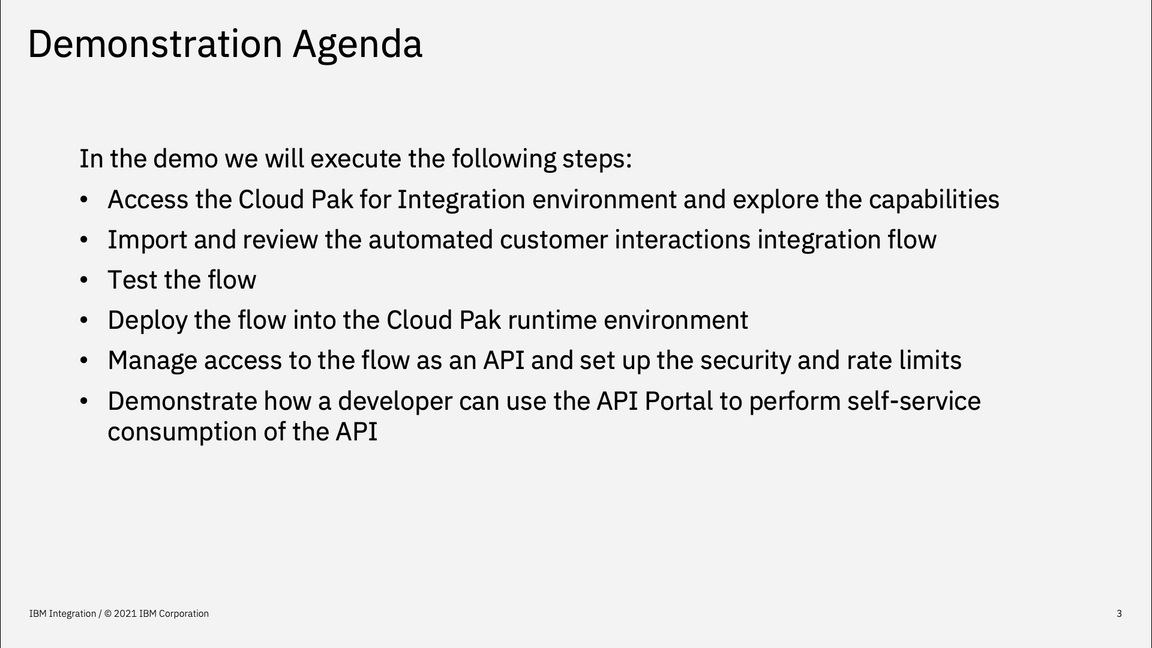
|
1.1 - Log in CP4I
| Log in CP4I | |
|---|
| Actions | Open CP4I and click Enterprise LDAP and Log in with your user and password. |
| Talking Points | As businesses execute a digital transformation, every organization seeks to move faster than before. But going fast without the right approach, guided by real-world operational data, has caused 70% of digital transformations to fail. A new approach with automation and continuous improvement fed by AI algorithms is required. IBM Cloud Pak for Integration is a hybrid integration solution that provides an automated and closed-loop lifecycle across multiple styles of enterprise integration. With IBM Cloud Pak for Integration, companies can speed integration development, reduce costs and maintain enhanced security, governance and availability. Let’s see IBM Cloud Pak for Integration in action. Here I have a cloud version of the product on IBM Cloud. Let me log in here. |
| Screenshots |
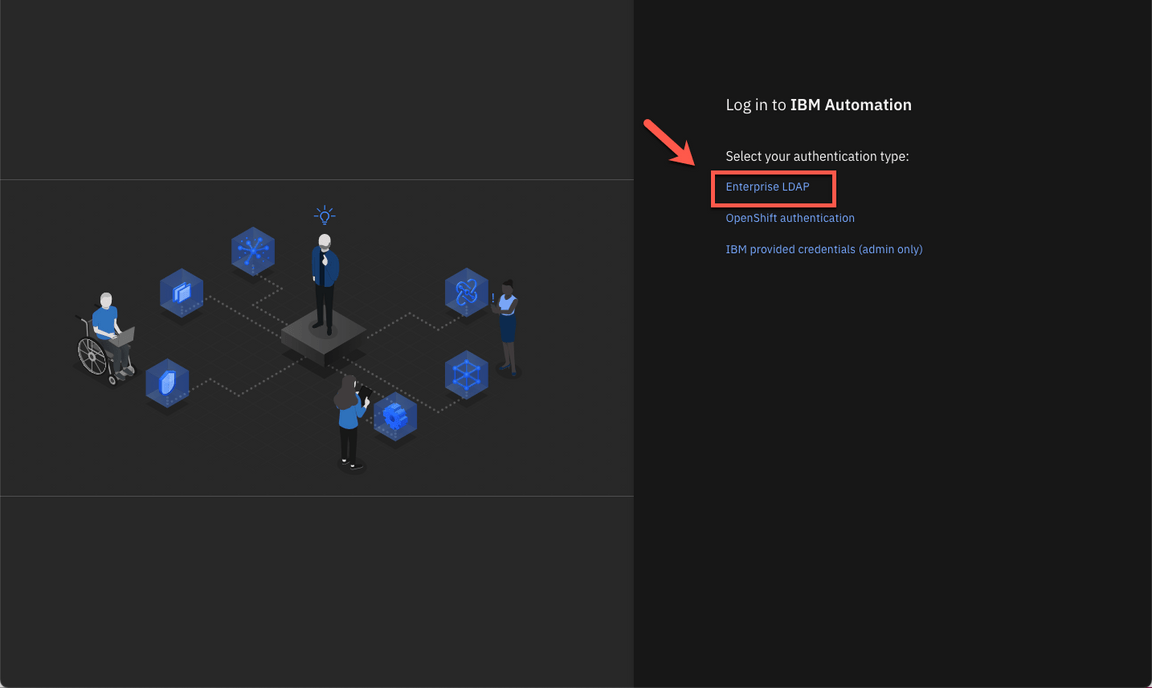

|
1.2 - CP4I Home
| CP4I Home | |
|---|
| Actions | Show the Home Page and open the menu, click on Administration > Integration Capabilities. |
| Talking Points | Welcome to IBM Cloud Pak for Integration! We’re now at the home screen showing all the capabilities of the pak, brought together in one place. Specialized integration capabilities —for API management, application integration, messaging and more —are built on top of powerful automation services. Let’s see the Integration Capabilities available in this Cloud Pak for Integration. |
| Screenshots |

|
1.3 - Integration Capabilities
| Integration Capabilities | |
|---|
| Actions | Show the Integration Capabilities page and open the Designer (ace-designer-demo). |
| Talking Points | As you can see, through a single interface you are able to access all the integration capabilities your team needs. Including API Management, Application Integration, Enterprise Messaging, Events, and High-Speed Transfer. In this demo to automate customer interactions with our company we will use App Connect for Application Integration, API Connect for API Management, and the Asset Repository as our centralized hub for allowing our teams to work together with Integration assets. Let’s open our App Connect Designer. |
| Screenshots |
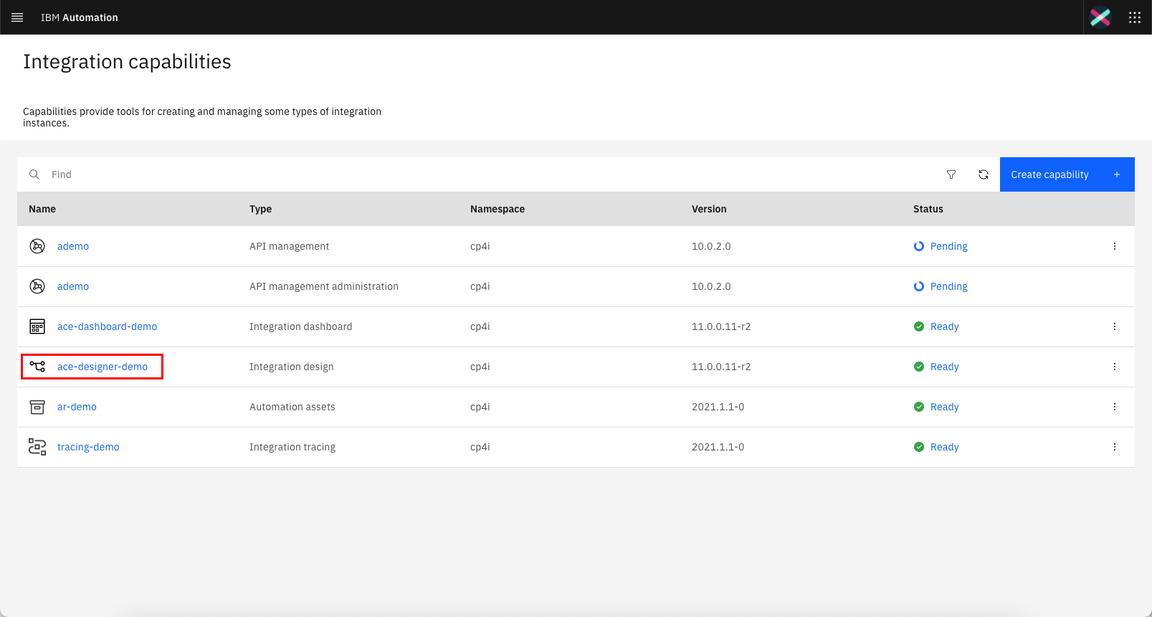
|
2.1 - Select Flow and review properties
| Review properties | |
|---|
| Actions | Select Car Insurance Cognitive API Lab Short V2 flow. Show the Properties view and click on Operations |
| Talking Points | Here we are in the designer tooling. This is where we can create all our API integration flows and manage our connectivity to our services and endpoints. We have a pre-created flow about a Customer Interaction scenario, let’s use it to simplify our demonstration.
These are the fields we are going to use for our API. Note that we tell our API which field is the key – in our case, CaseReference. Let’s check the Operations. |
| Screenshots |
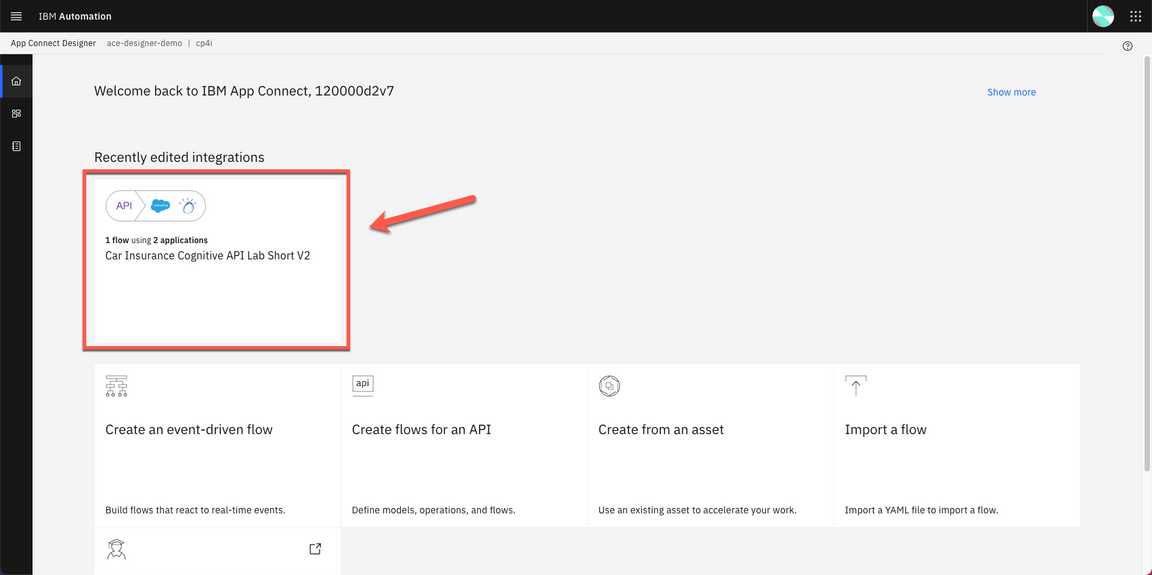
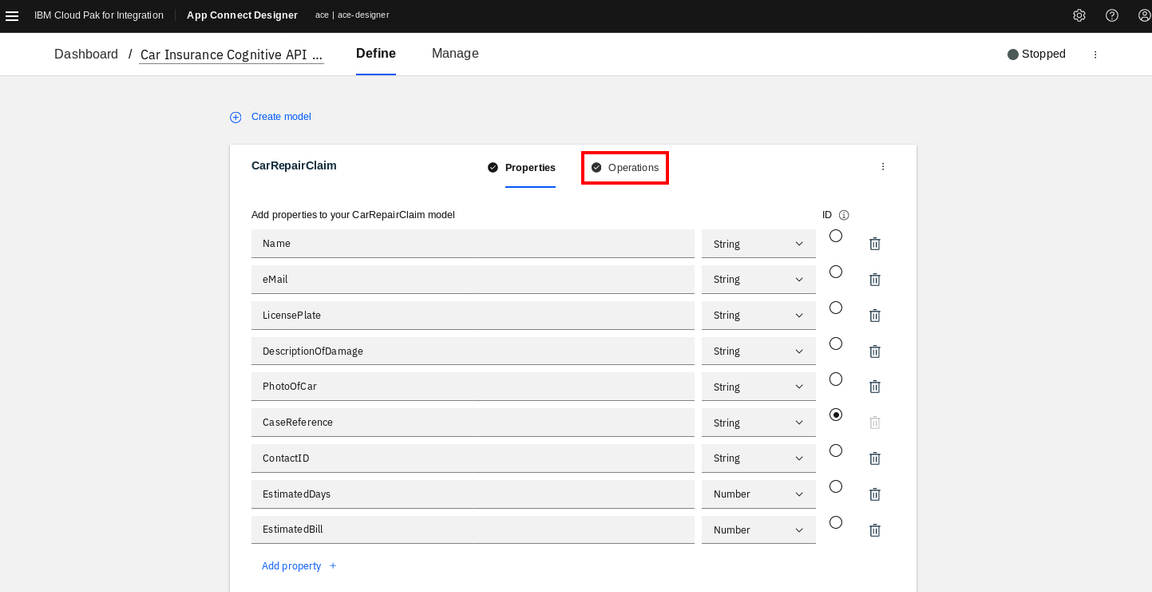
|
2.2 - Review operations
| Review operations | |
|---|
| Actions | Show the Operations view and click on View flow |
| Talking Points | In the Operations view are the actions that the API exposes along with the data. In this demo, we’re going to build just one operation – “Create Car Repair Claim”. We can add more later if we wish. Let’s check the flow logic. |
| Screenshots |
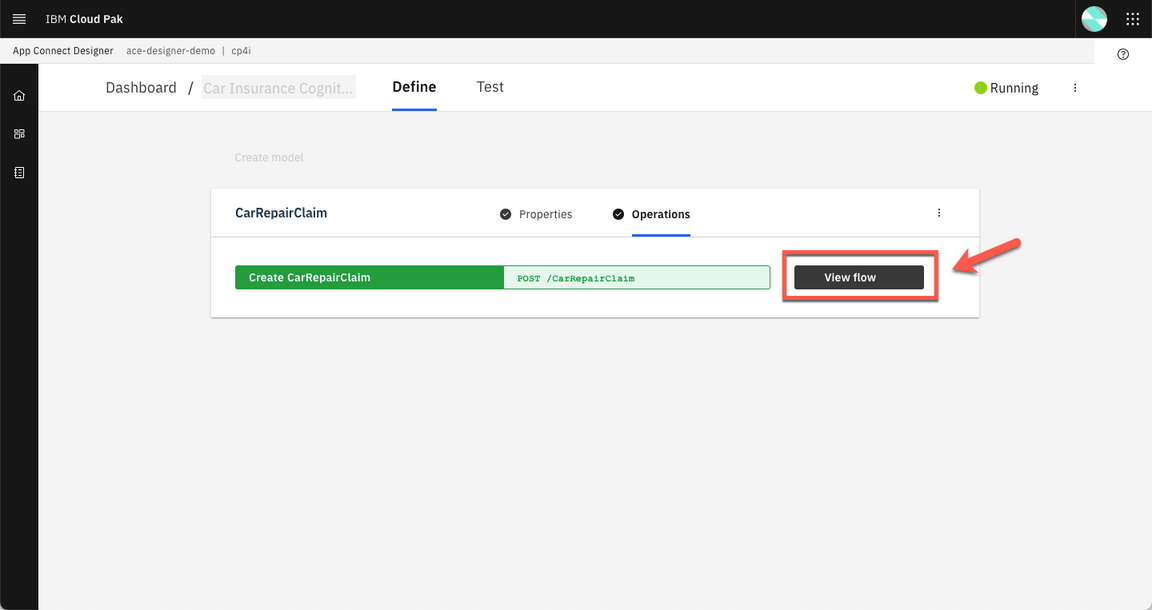
|
2.3 - Review the flow
| Review the flow | |
|---|
| Actions | Explain the Flow and Scroll through all of the connectors in the flow. After that, open the Request again, by clicking the first step of the flow. |
| Talking Points | Here we have our demo flow. In the designer flow editor, we can edit and change our flow. We are a Car Repair company: We take in vehicles with problems and repair them. We want to create an API which enables customers to send us photos of their cars along with descriptions of what needs to be done. With this information, we will create a case in Salesforce and use Watson to analyze if the customer is angry or upset. Let’s explore our flow in detail. |
| Screenshots |

|
2.4 - Review Request
| Review Request | |
|---|
| Actions | Show the Request dialog (1). Click to open the if step (2). |
| Talking Points | Our flow starts by receiving the customer’s car repair request with photo via an API. Designer automatically creates an API “Request” and “Response” for your API flow. |
| Screenshots |

|
2.5 - Checking the Photo
| Checking the Photo | |
|---|
| Actions | Explore the IF step (1) and click on Salesforce Connector - Retrieve contacts (2). |
| Talking Points | Second, we validate the photo. Here, we have a simple IF statement, that checks if the PhotoOfCar is empty. If it is not empty, we move forward to retrieve contacts by connecting to Salesforce. |
| Screenshots |
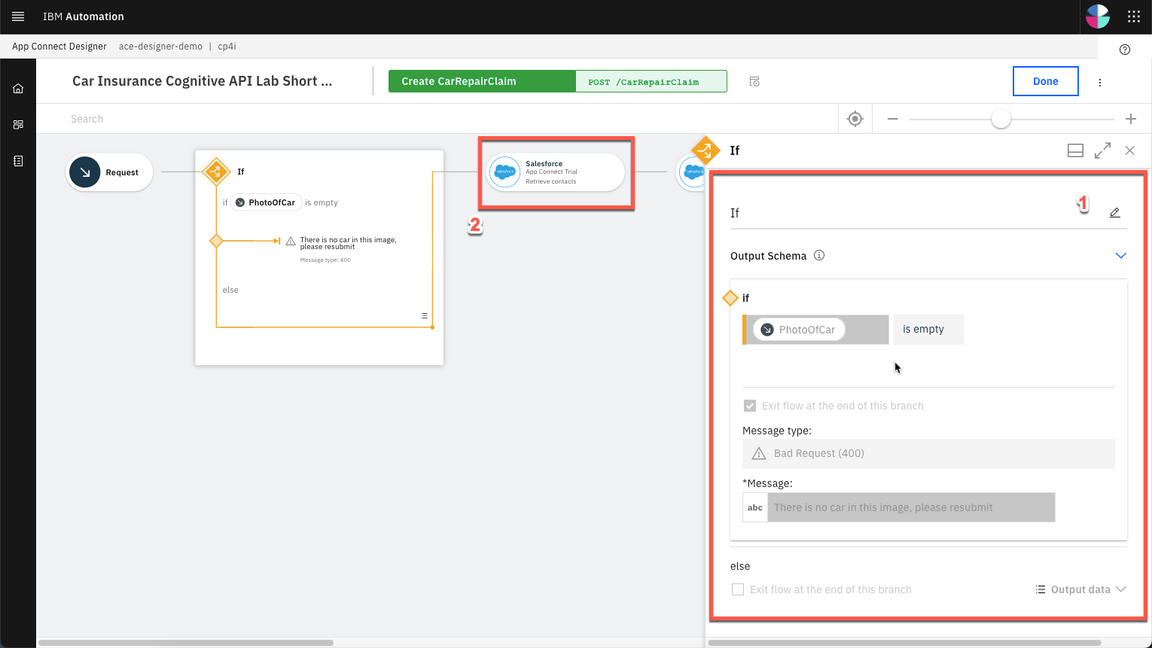
|
2.6 - Retrieve contacts
| Retrieve contacts | |
|---|
| Actions | Explore the Salesforce Connector - Retrieve contacts (1). Close all the dialog tabs. Click on the Salesforce – Create case node (8). |
| Talking Points | Third, we use a connector to create a case in Salesforce with the data from the API. This Case is where we store the details and progress of our repair. We are using a hard-coded contact name: ‘Andy Young’. He’s the contact for the insurance company that sends customers. Salesforce Developer Accounts have a prepopulated set of data that you can use to test. ‘Andy Young’ is one of those prepopulated contacts. |
| Screenshots |
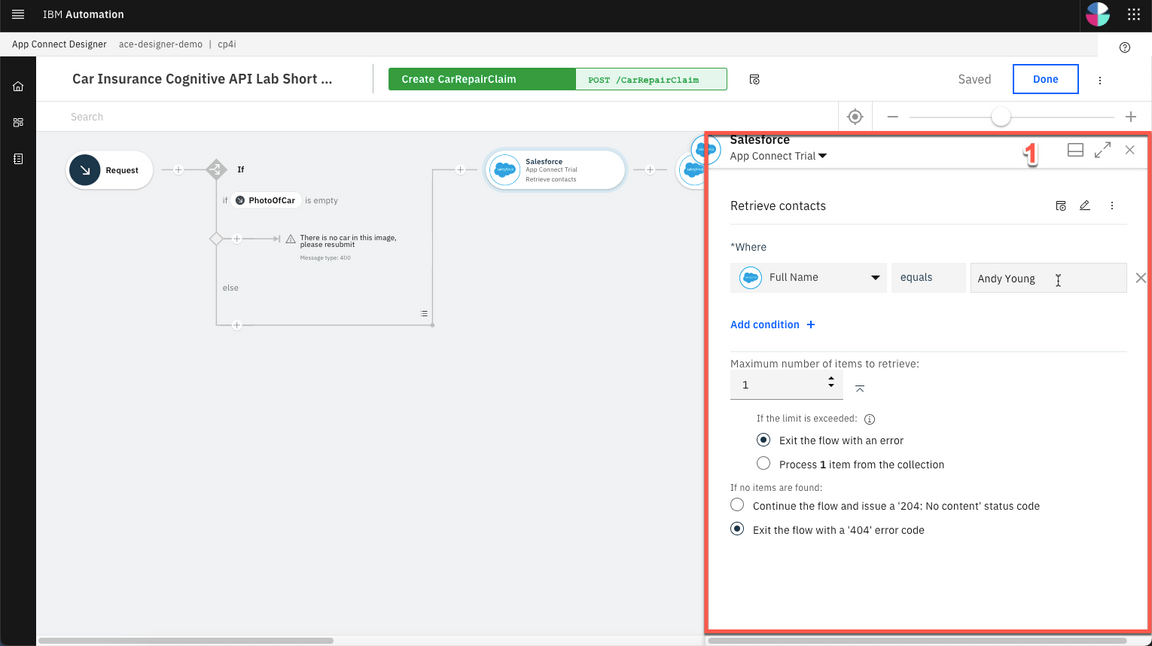
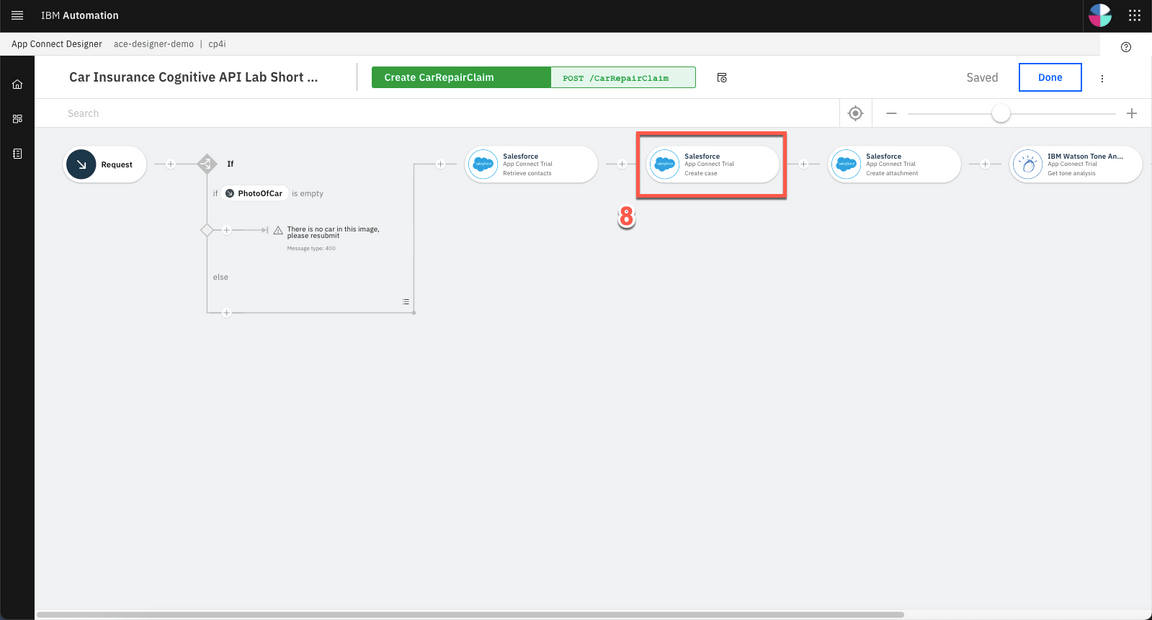
|
2.7 - Create Case
| Create Case | |
|---|
| Actions | Explore the Salesforce – Create case node. Close the Salesforce connector dialog. Open the Salesforce - Create Attachment node. |
| Talking Points | Now we have the ID that we need, let’s create our Salesforce case. Note that we just re-use the same Salesforce connector but with a different operation and data. Here we can see that our contact ID comes from the previous ‘retrieve contact’ Salesforce Call. The Name and email come from the API Request. The connector ‘knows’ that fields like ‘Case Type’ have a limited number of values in Salesforce – so it automatically converts them into pull-down lists of values you can choose. |
| Screenshots |
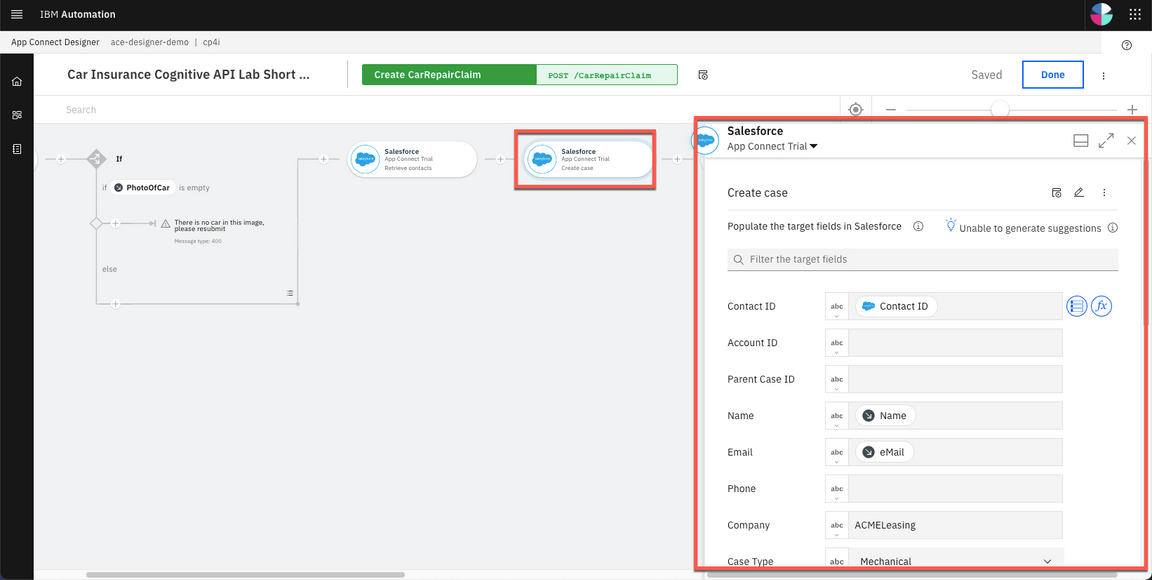
|
2.8 - Create Attachment
| Create Attachment | |
|---|
| Actions | Explore the Salesforce – Create Attachment node (1). Close the Salesforce connector dialog. Open the IBM Watson Tone Analyzer node (2). |
| Talking Points | To add a photograph, we need to create a salesforce attachment – that’s easy, just use the connector again. Note that we use the Case ID that is a returned value from the ‘Create Case’ connector call – it’s been kept in the flow automatically. We send the PhotoOfCar as a base64 string and we tell Salesforce that the content Type is image/jpeg. Moving forward to the next step we want to understand the tone of the request. Is the customer angry? We will use the IBM Watson Tone Analyzer node to understand the situation better. |
| Screenshots |
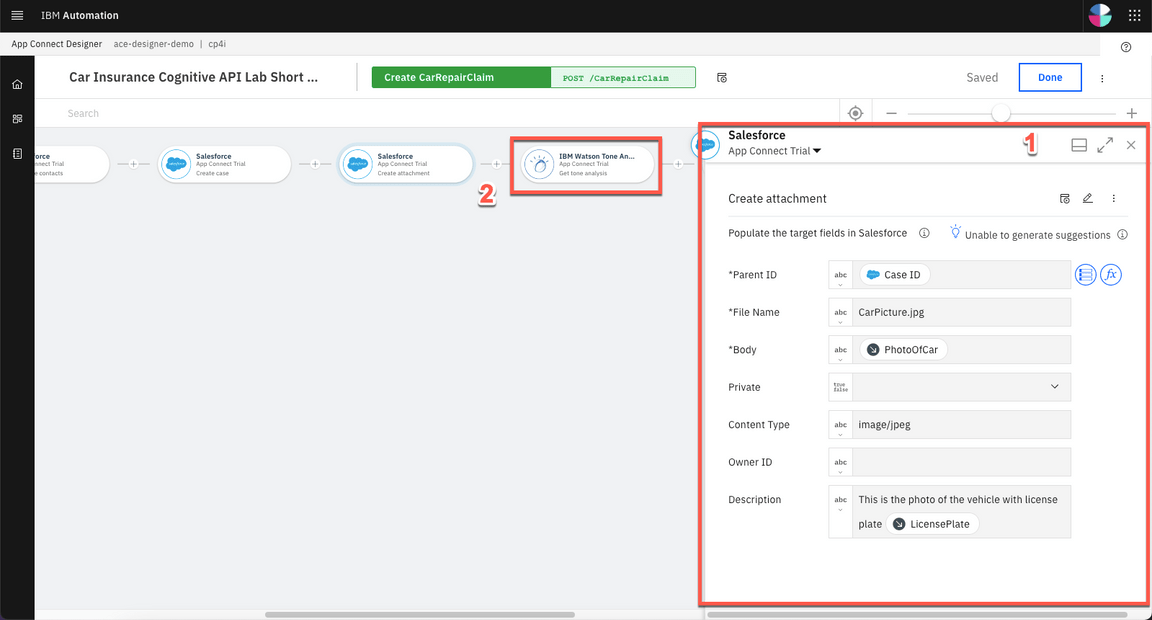
|
2.9 - Analyze the description
| Analyze the description | |
|---|
| Actions | Explore the Watson Tone Analyzer connector (1). Close the Tone Analyzer connector dialog. Open the Salesforce - Create case comment (2). |
| Talking Points | Here, the Watson Tone Analyzer service analyzes the description shared by the customer, to identify if the customer is angry or upset, that demands further action or the need to treat them more carefully. |
| Screenshots |
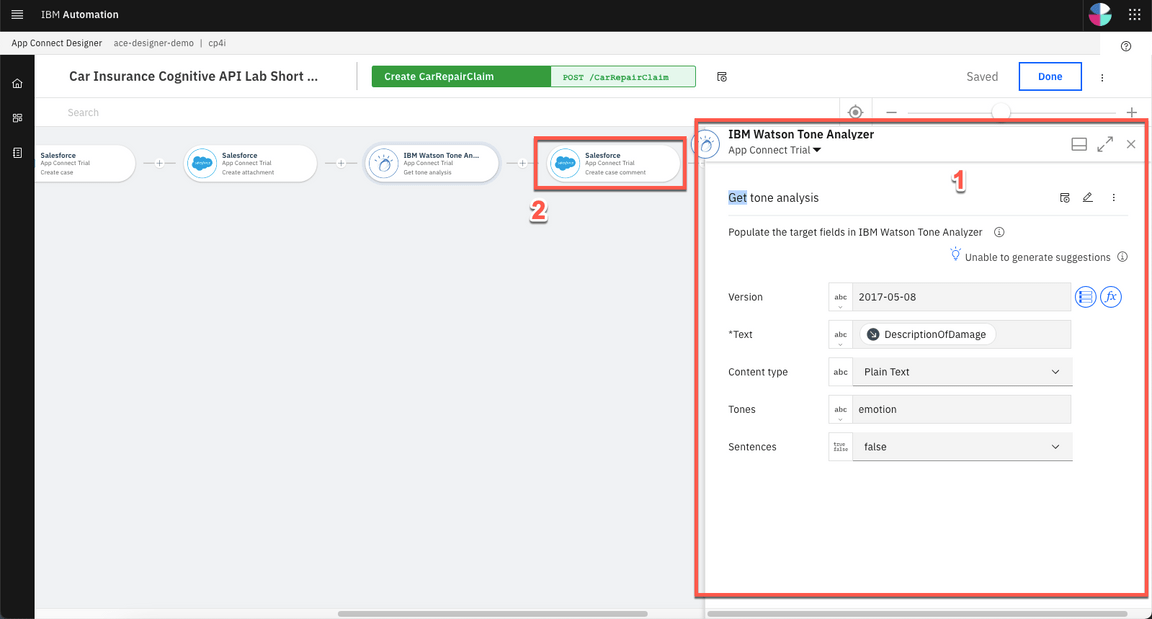
|
2.10 - Create case comment
| Create case comment | |
|---|
| Actions | Explore the Salesforce – Create case comment node (1). Close the Salesforce connector dialog. Open the Response. (2) |
| Talking Points | Then we’ll add a comment to the case with the Salesforce connector and supply the tone name returned from Watson into the body of the comment. |
| Screenshots |
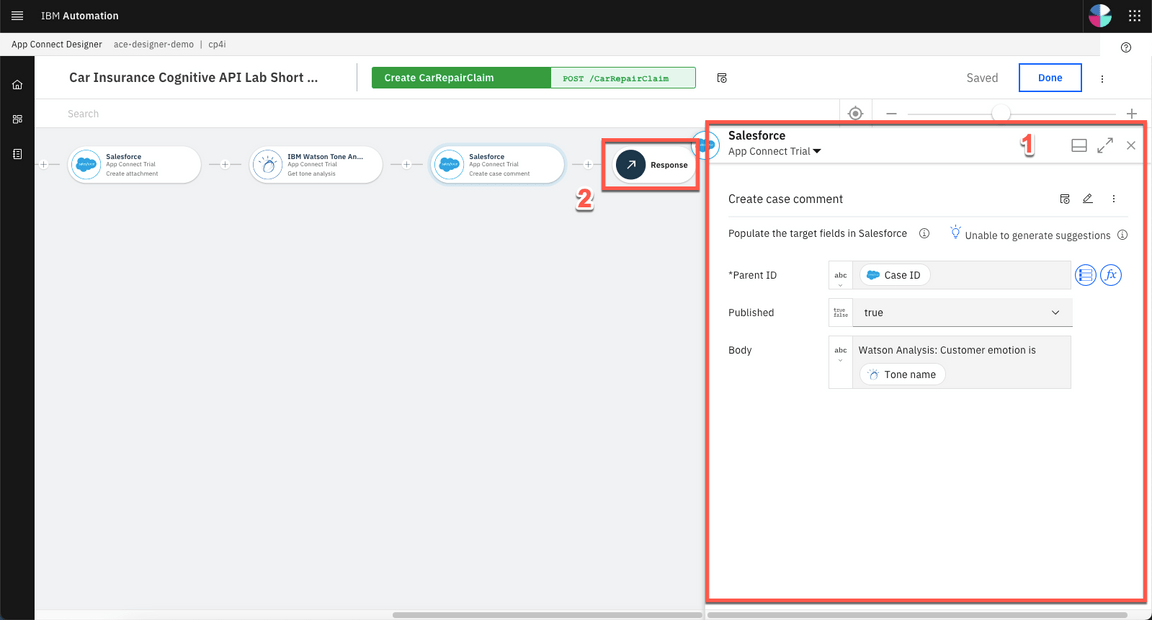
|
2.11 - Response
| Response | |
|---|
| Actions | Explore the Response dialog (1). Click Done (2). |
| Talking Points | Here, we have the response that we submit back to the customer after the API call. This response includes their Salesforce case reference for future enquiries and also an estimate of how long it will take to repair and how much it will cost. Great. we’ve reviewed the flow, now let’s see our API running in our Integration Runtime |
| Screenshots |
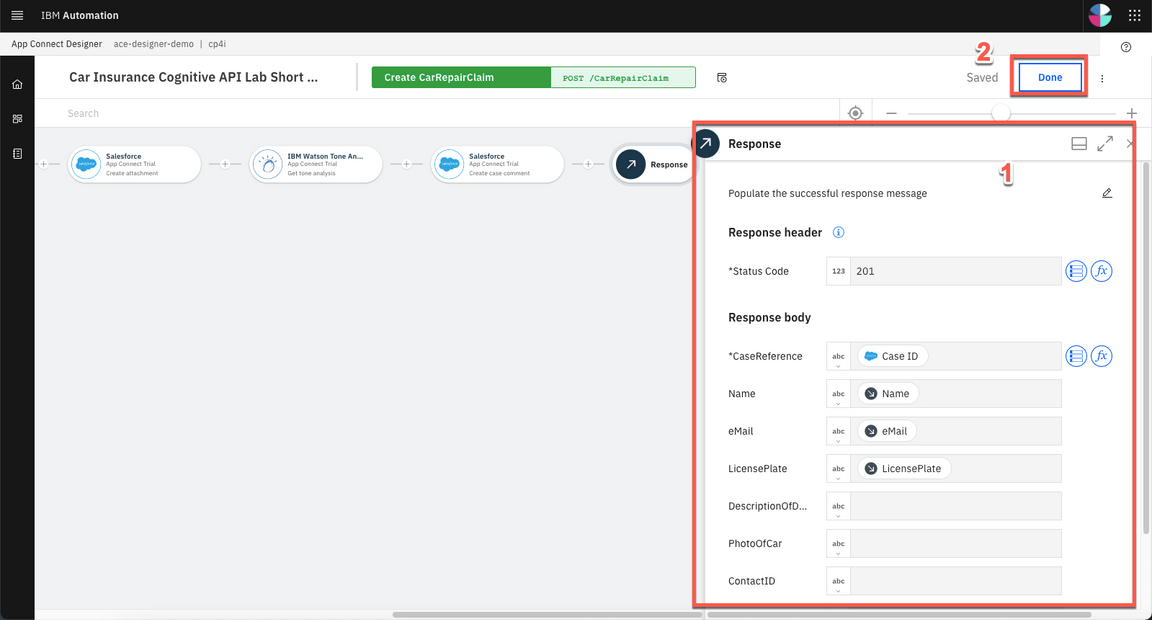
|
2.12 - Verify the Server
| Verify the Server | |
|---|
| Actions | Open the Menu and select Run > Integration. Select the ace-dashboard-demo instance. Click on Servers. Select carrepair-server. Open our API Flow (2). Explore the API details (3). |
| Talking Points | Great, now let’s check the API running in Integration Runtime. Here we have our Integration server. At this point, the integration is running on the cloud pak. Opening the server, we can see our API Flow. And click again, we’ll drill down further and see our API details. We can see the REST operation, the base URL and we can even download the OpenAPI document. Great, our API is running in our Integration Runtime. Later, we will test this API using the Developer Portal. But now let’s explore another great capability API Manager. Let’s see the benefits to have an API Manager to control our API lifecycle! |
| Screenshots |
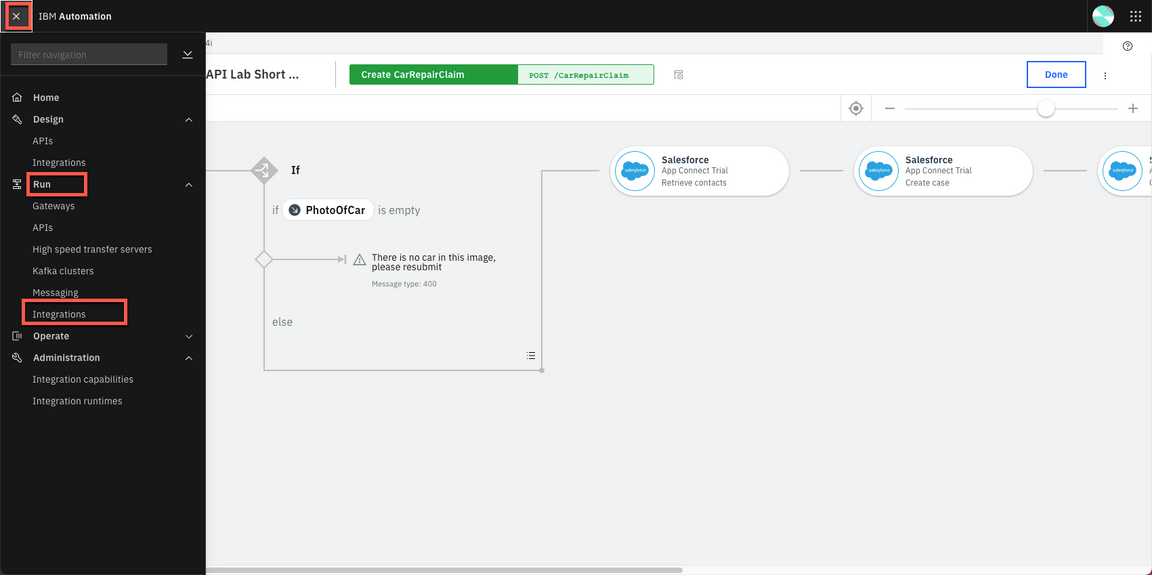
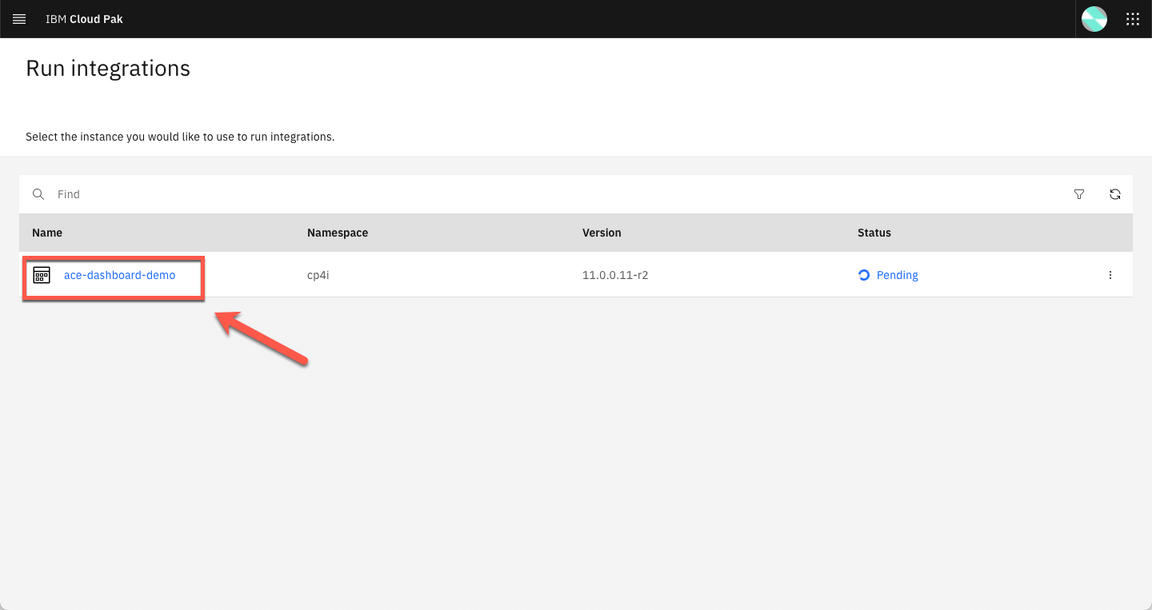


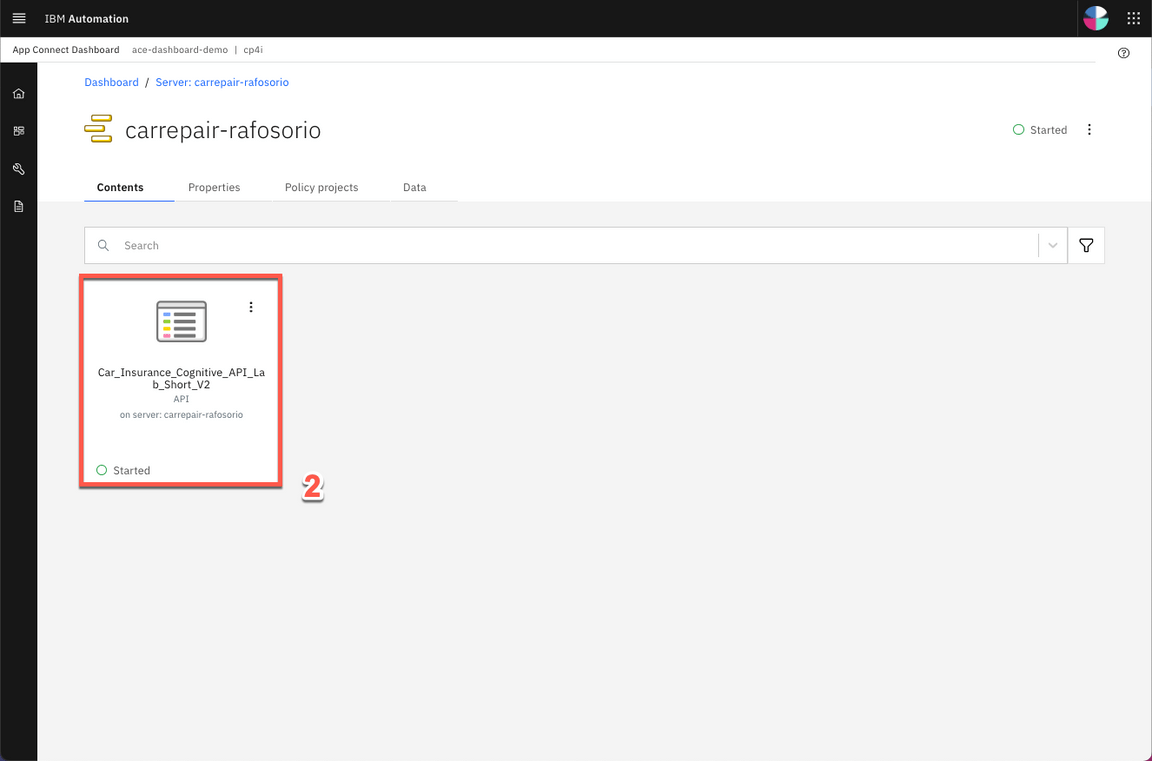
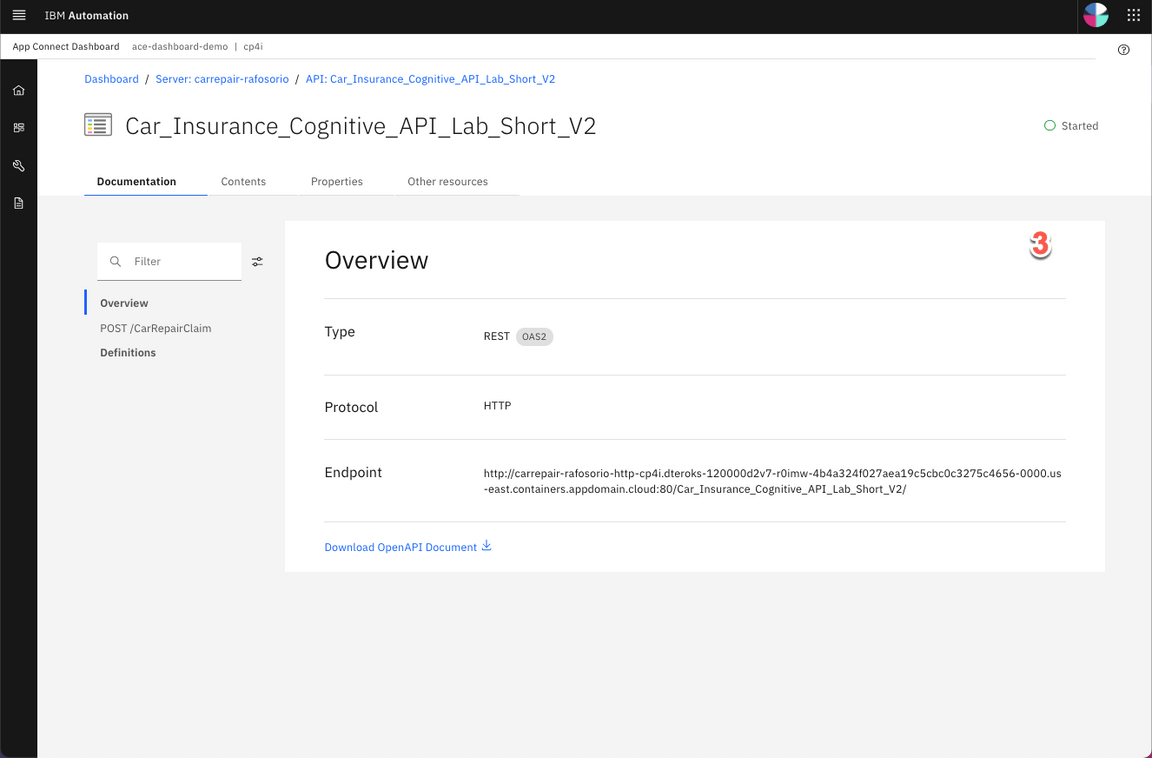
|
3.1 - Accessing API Connect
| Accessing API Connect | |
|---|
| Actions | Open the Menu (1) and on Run (2) section, select APIs (3). If necessary, select the ademo instance (4). In the API Connect page, click LDAP User Registry for Outcomes (5). Log in with your Outcomes user and password (6). |
| Talking Points | Now, let’s open API management component inside the Cloud Pak for Integration - API Connect. IBM API Connect is an integrated API management offering, with capabilities and tooling for all phases of the API lifecycle. Key steps of the API lifecycle include create, secure, manage, socialize, and analyze. API Connect has four major components: API Manager, Analytics, Developer Portal, and Gateway. Now, let’s explore the API Manager. |
| Screenshots |
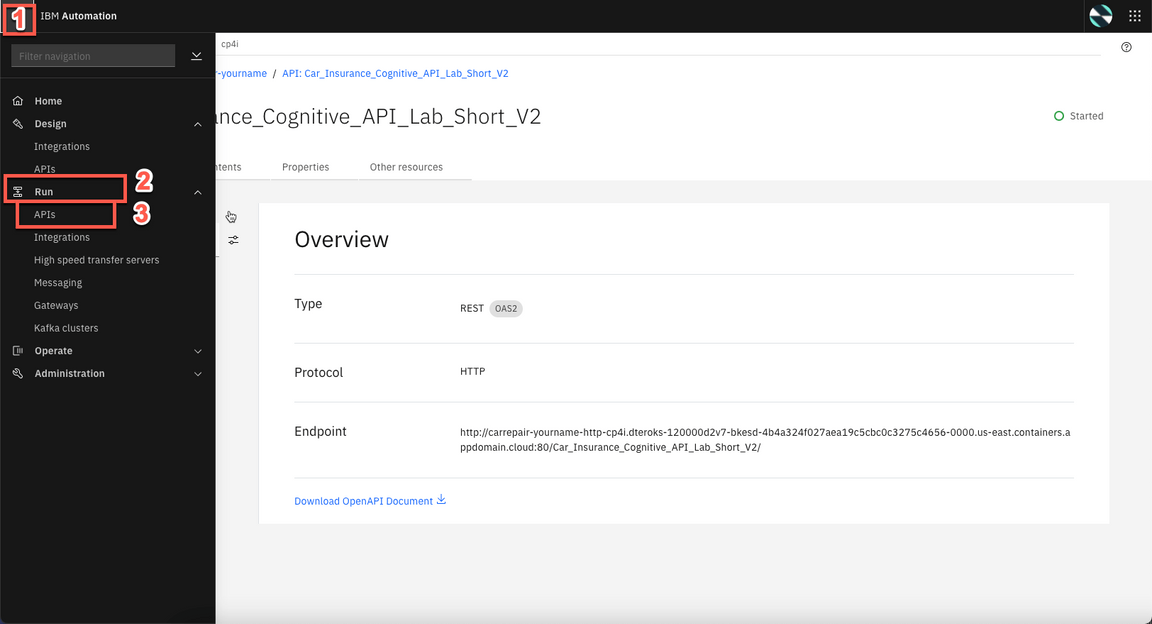
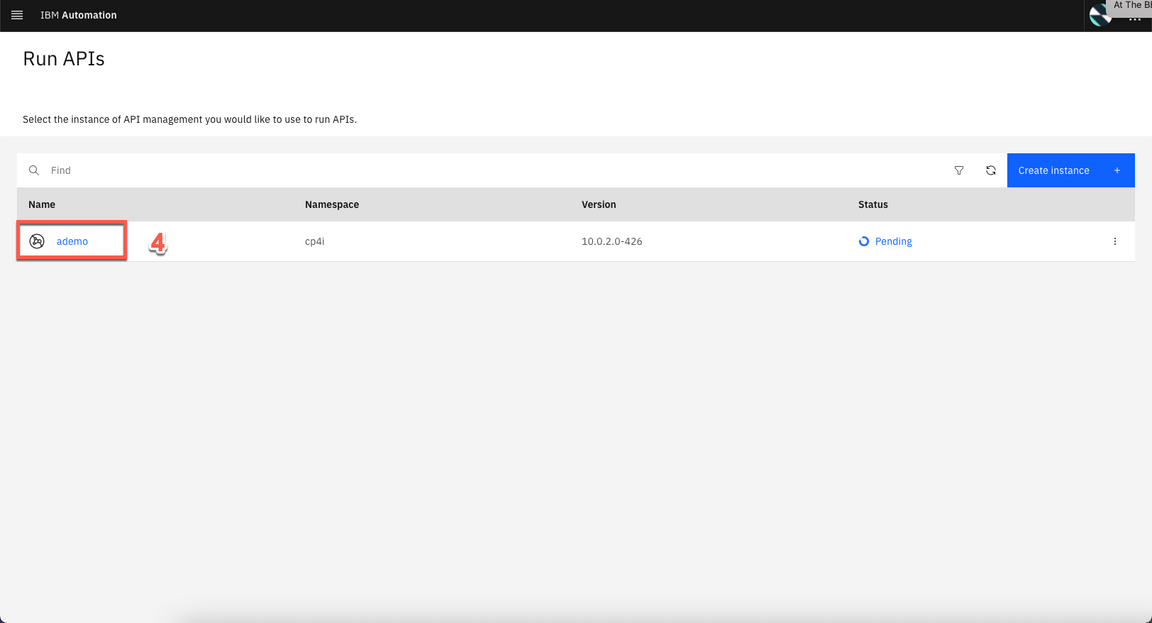

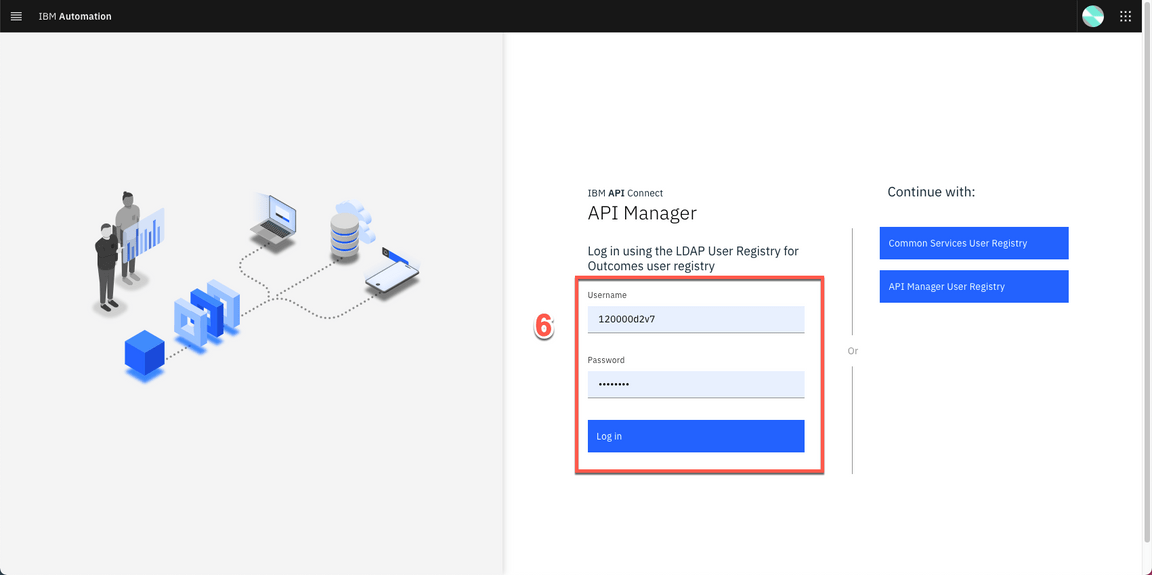
|
3.2 - Develop API
| Develop API | |
|---|
| Actions | Click Develop APIs and Products (1). Click Car_Insurance_Cognitive_API_Lab_Short_V2 (2), then open Security definitions (3). Explore the Security definitions page (4). Click Develop on breadcrumbs (5). |
| Talking Points | Now, let’s check our API here in API Manager. To simplify the demo, our API is pre-assembled here in the API Manager. In the Develop page, we are able to edit, assemble, secure and test APIs. In the Security definitions, we can control client access to API endpoints, for example using API key validation. |
| Screenshots |
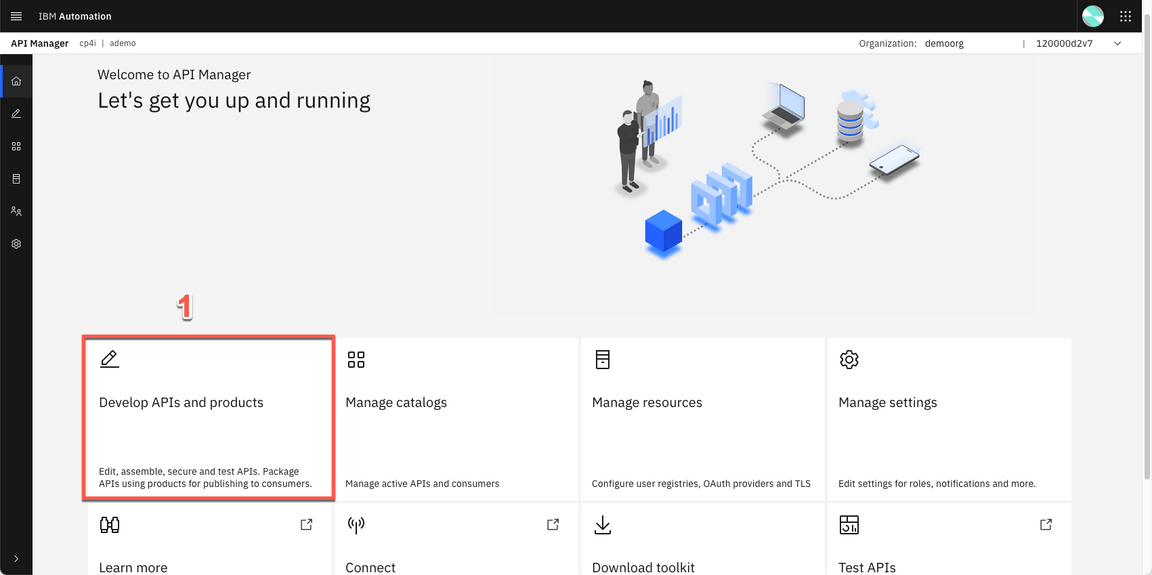
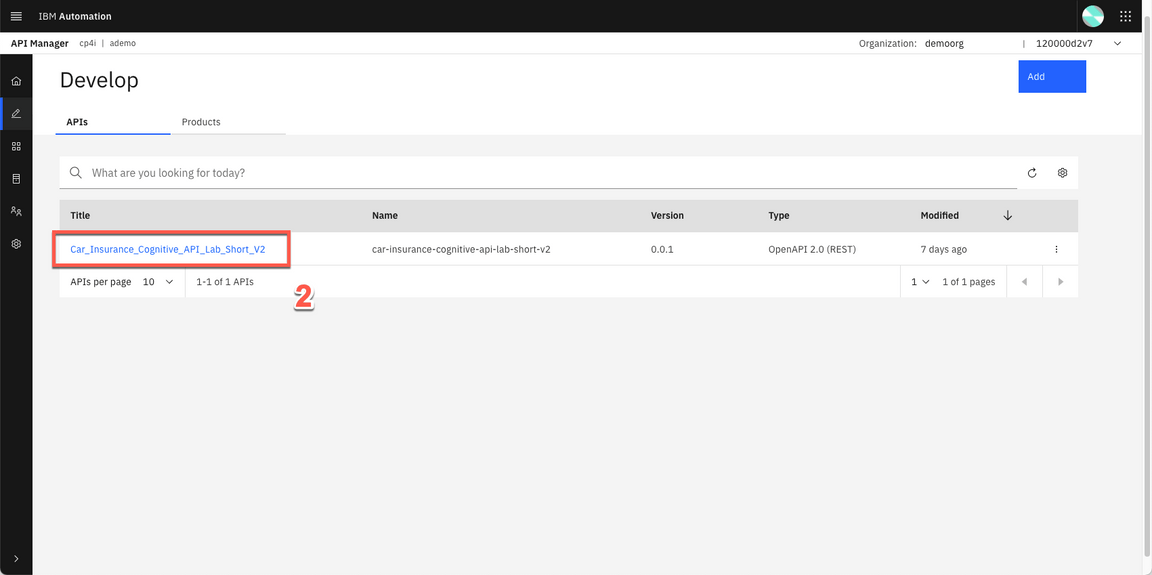
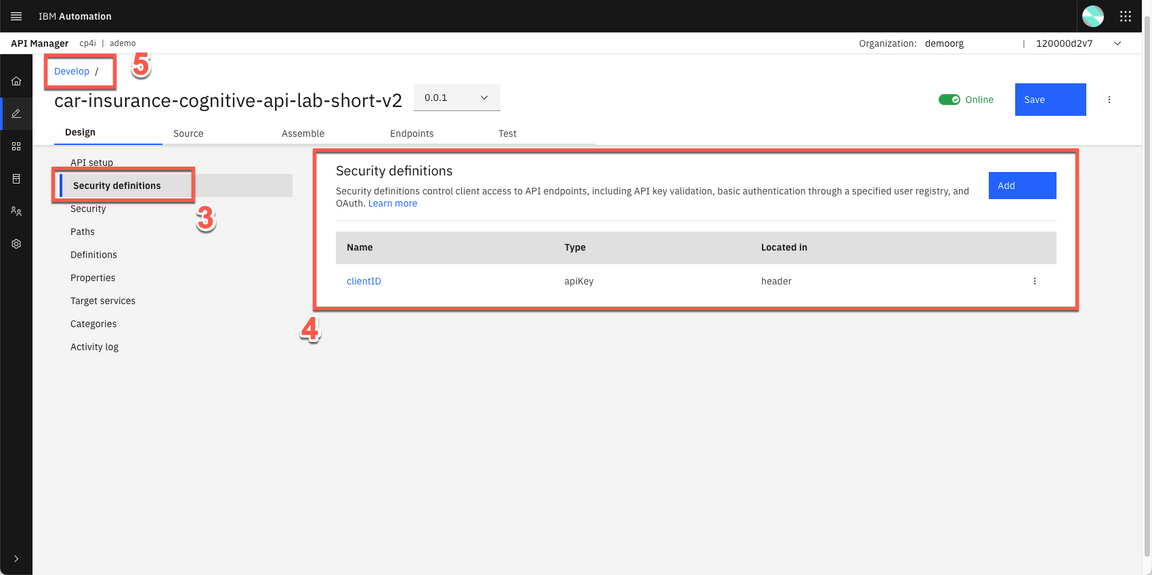
|
3.3 - Develop Product
| Develop Product | |
|---|
| Actions | Click Products (1). Click Car Repair APIs product (2). Open the Plans (3) tab. And on the context menu of Gold Plan and select Edit (4). Explore the Rate Limits section (5). Just show, how simple is to publish the Product and API, clicking Menu > Publish (6) (Note: you don’t need to publish, because the product is already published). |
| Talking Points | Now, let’s see how we package our APIs using products for publishing to consumers. To simplify the demo, our Product is already created here in the API Manager. Products are packages that contain both the APIs and the accompanying Plans. The providers use Plans to control access to APIs and to manage API usage. Plans can use differing rate limits to provide different levels of service to API consumers. In our product, we already have two plans, the Gold and the default plan. We can have multiple plans for different consumers, for example we can add approval steps for consumers when they sign up or we can allocate them plans as a provider. For example, our Gold Plan permits up to 100 calls per minute. Great our API and Projects are ready to be published for our API consumers. |
| Screenshots |
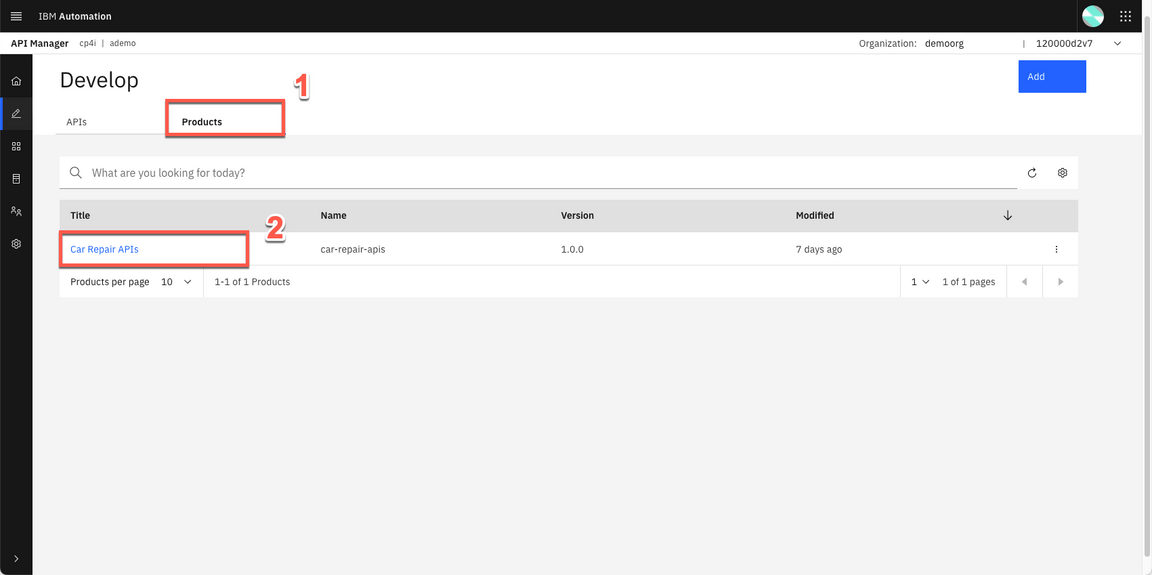

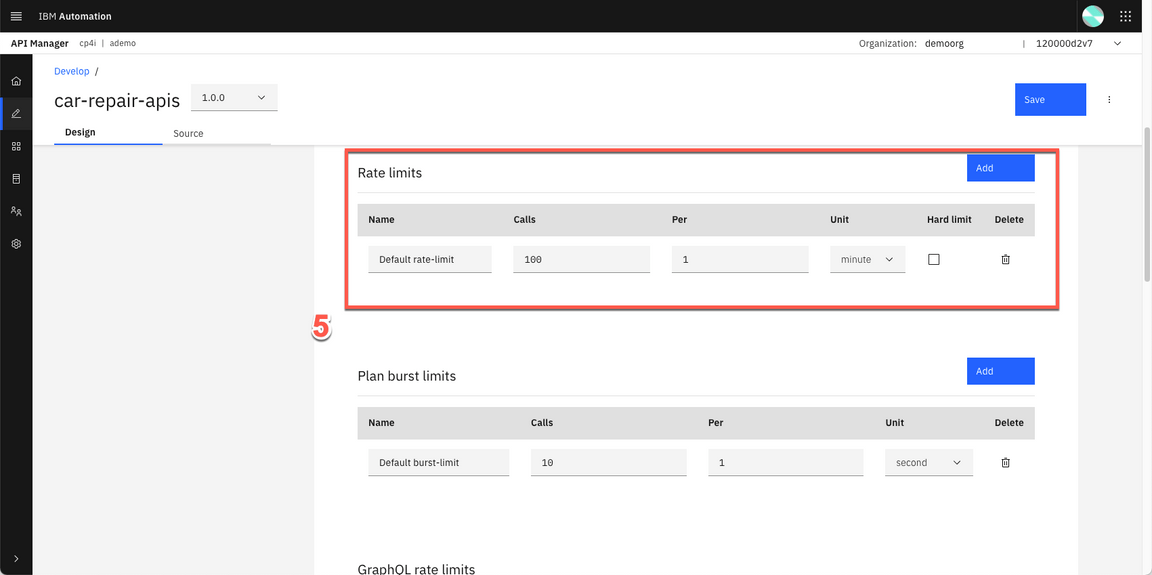
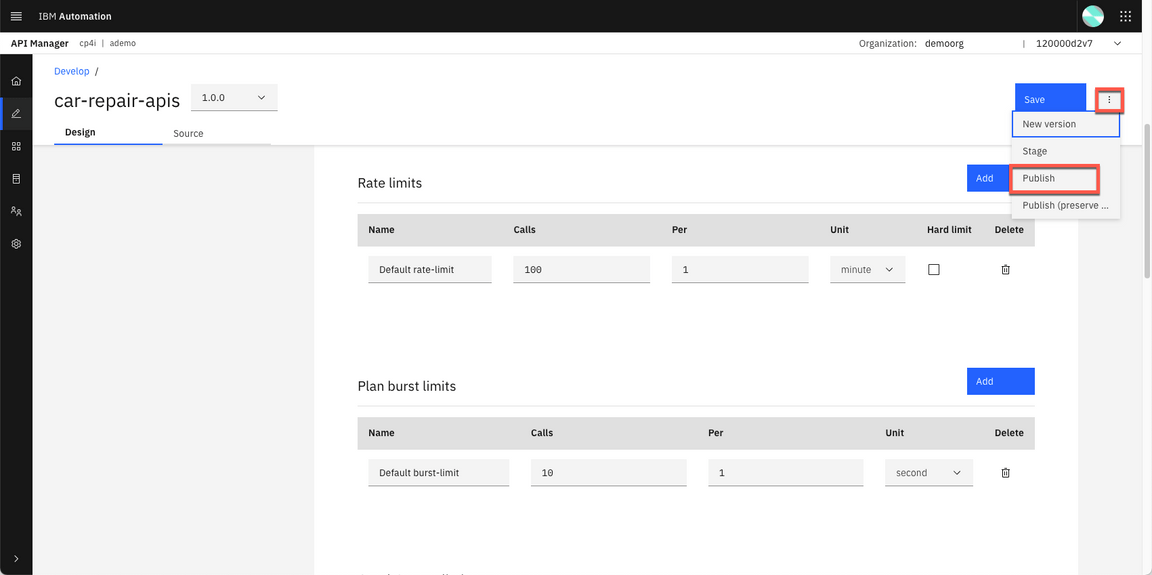
|
4.1 - Accessing Portal
| Accessing Portal | |
|---|
| Actions | On the left navigator menu, open Manage page. Open the Sandbox catalog. Open the Catalog settings (1). Click Portal (2). Copy the Portal URL (3). Open a new Browser tab and access the Portal URL. Create a developer account by clicking Create account (4). Use your personal email to complete the registration (5). You need to access your email to accept the invitation, after that, you just need to Sign in (6). |
| Talking Points | For this demo, our API is already published. Now we need to make sure that our API consumers can discover it and use it. Our Portal allows potential API consumers to view the APIs, sign up and subscribe to plans in a self-service manner, test the APIs, download the OpenAPI - Swagger documents and more. Let’s get our portal URL and sign up as a Consumer of our API using Portal Self-Service. |
| Screenshots |

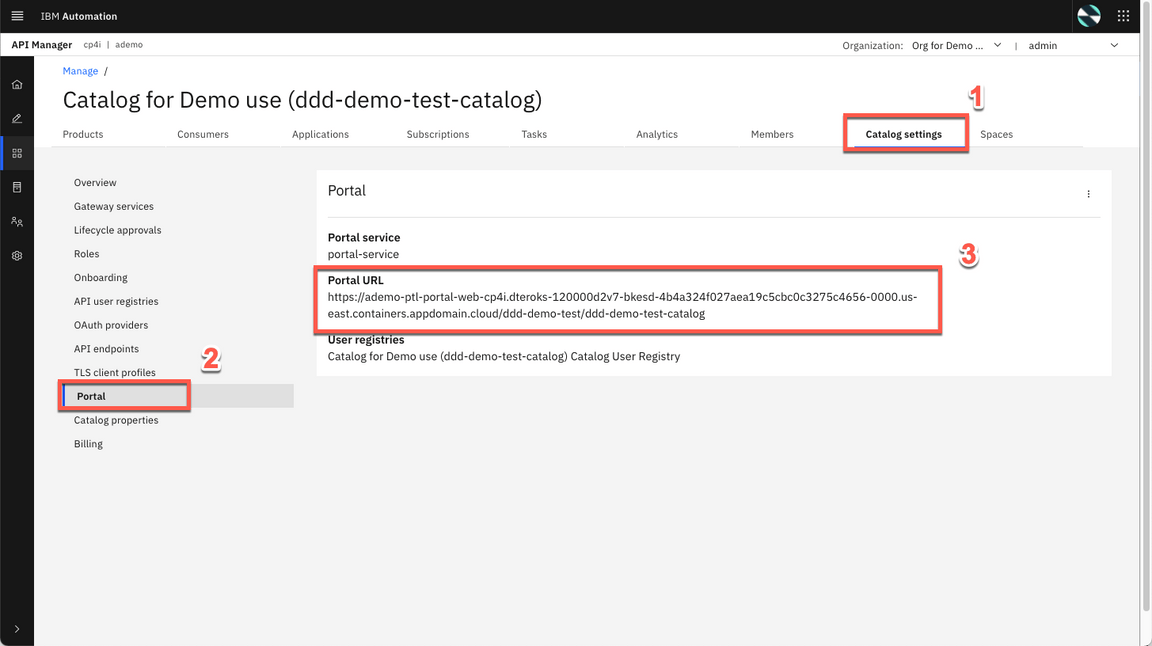

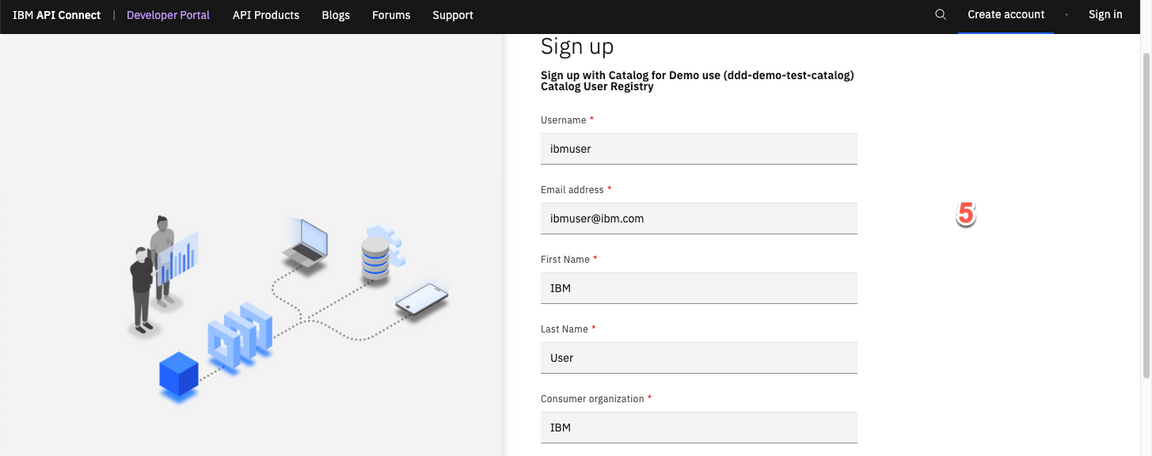
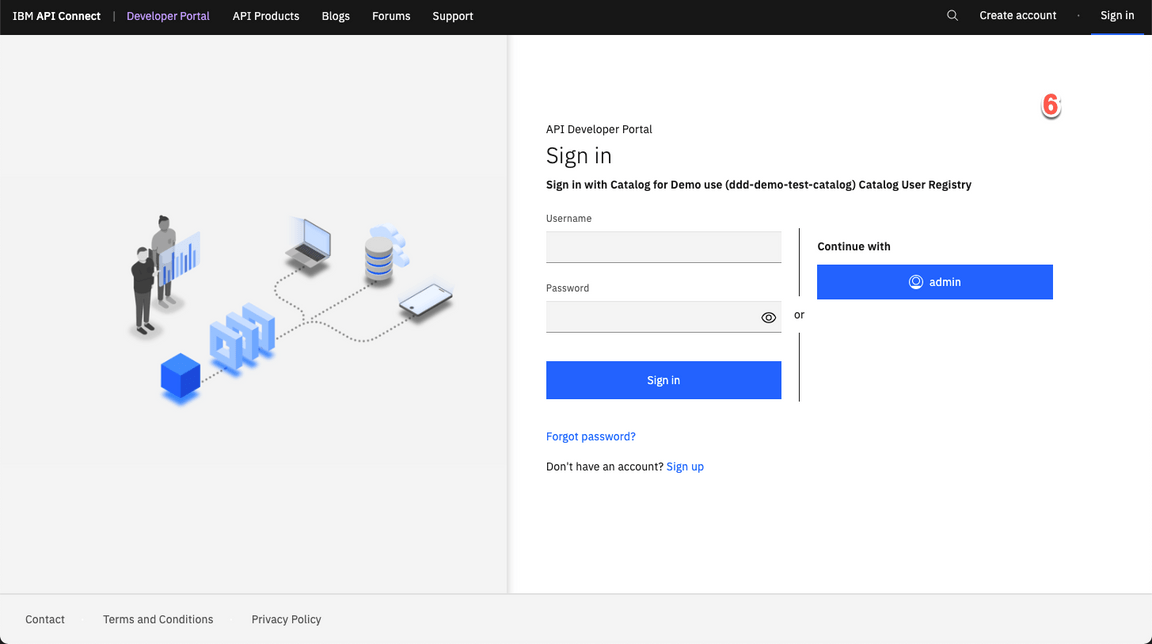
|
4.2 - Create a new App
| Create a new App | |
|---|
| Actions | Click Create a new App (1). Enter Car Repair Application as App Title (2). Click Save (3). On the credentials dialog, click OK (4). On the Subscription tab, copy the Client ID (5). |
| Talking Points | As a Consumer/Developer, we’re going to create a new application in the Portal. This will give us an API key so we can call our APIs. We just need to give an Application Title and copy the API Key and Secret. |
| Screenshots |

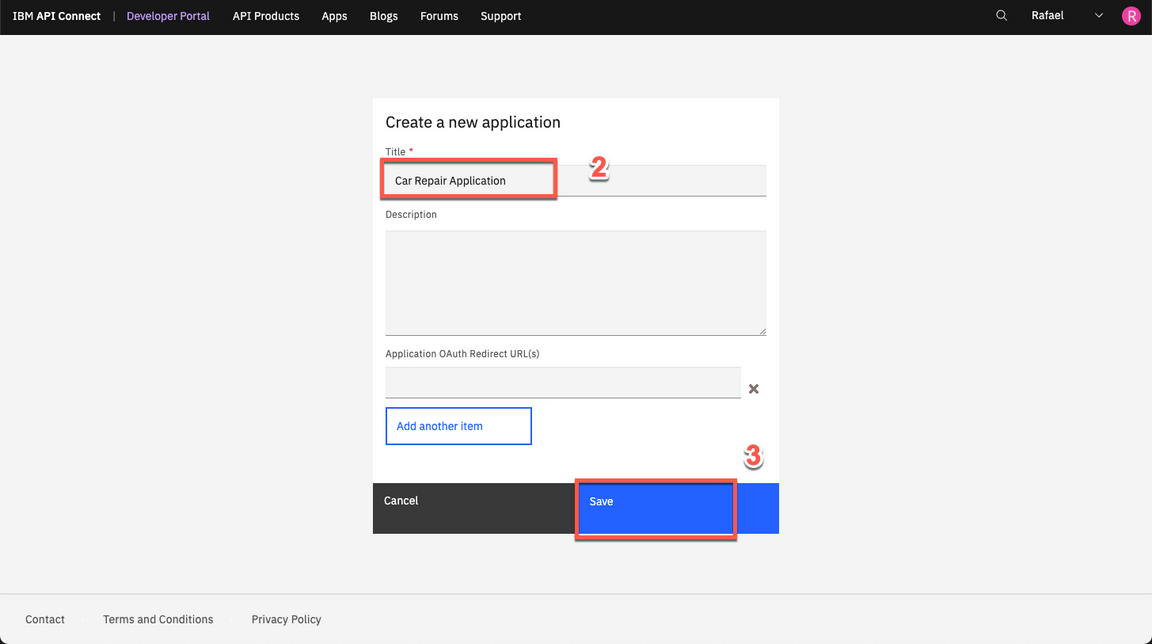
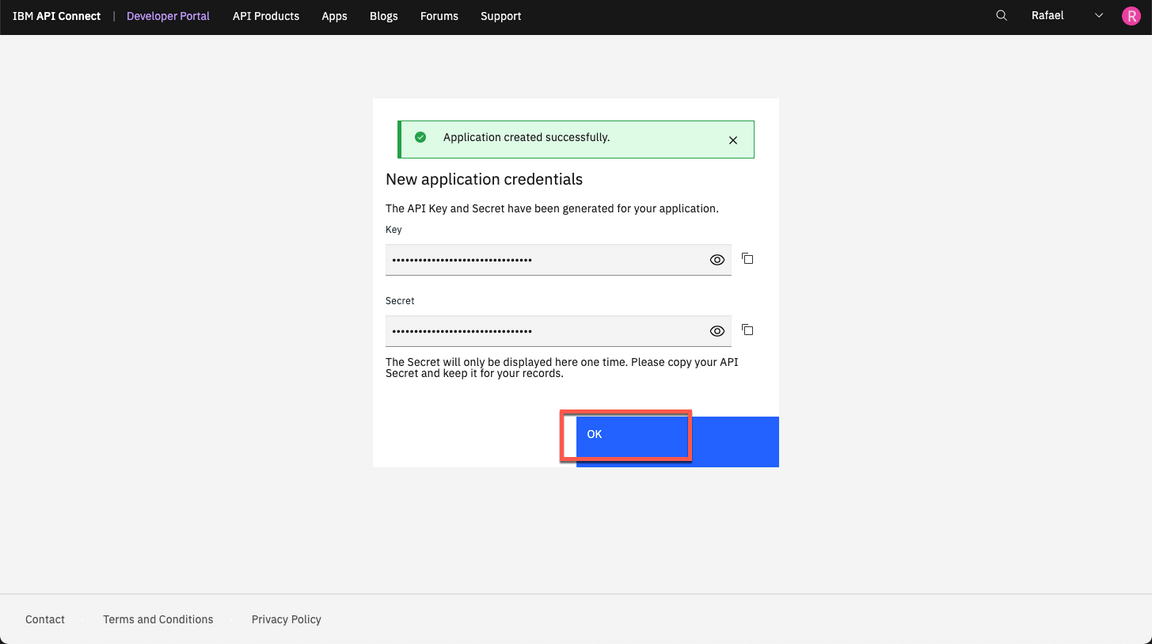
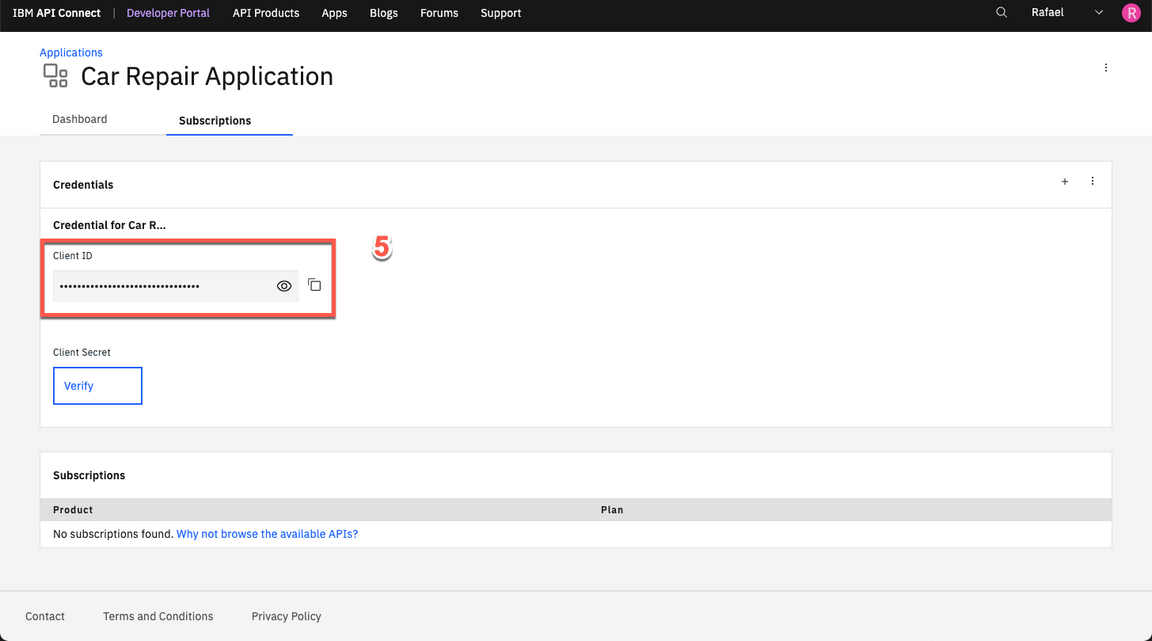
|
4.3 - Subscribe to API
| Subscribe to API | |
|---|
| Actions | Click Why not browse the available APIs? (1). Click Car Repair APIs 1.0.0 (2). On Gold Plan, click Subscribe (3). Select the Car Repair Application (4). Confirm the Subscription by clicking Next (5). Click Done (6). |
| Talking Points | We’ve not subscribed to any APIs, let’s do it now. There’s only one API Product to subscribe to in our demo – normally there would be many. Now that we selected our API product, we can see the plans available. You’ll need to hover over to get the limits – we want the gold plan. We want to subscribe to the plan – but which application do we want to use to subscribe? We can have many applications but, in this demo, we’ve only created one. So, we just need to select the App that we created earlier and confirm our subscription. And Done - we are subscribed to our API! |
| Screenshots |
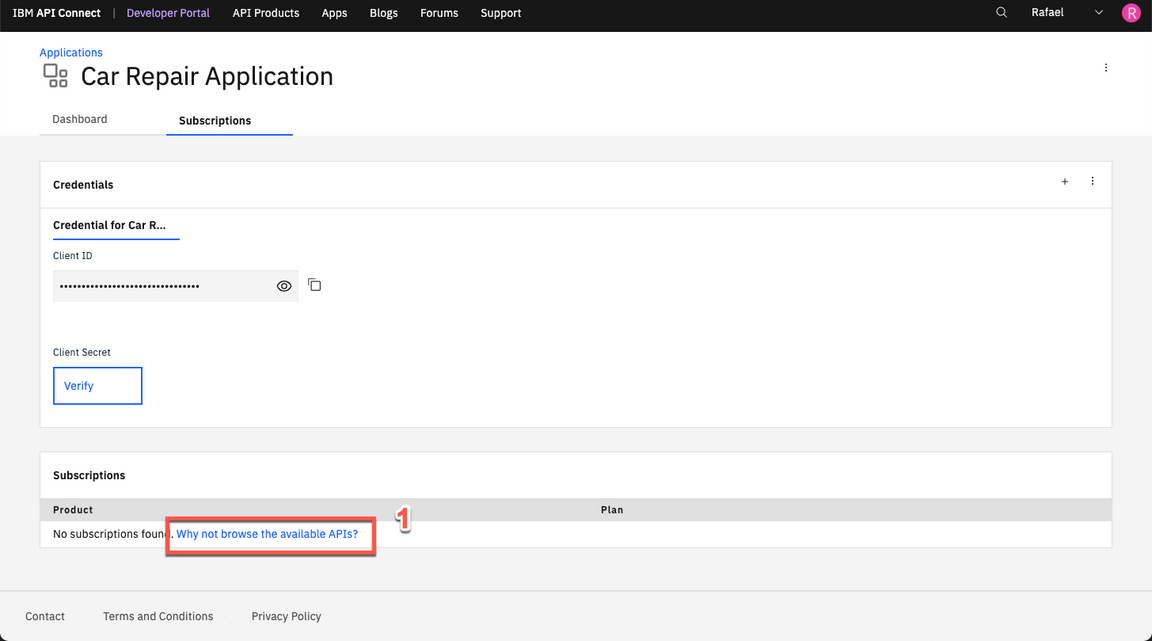
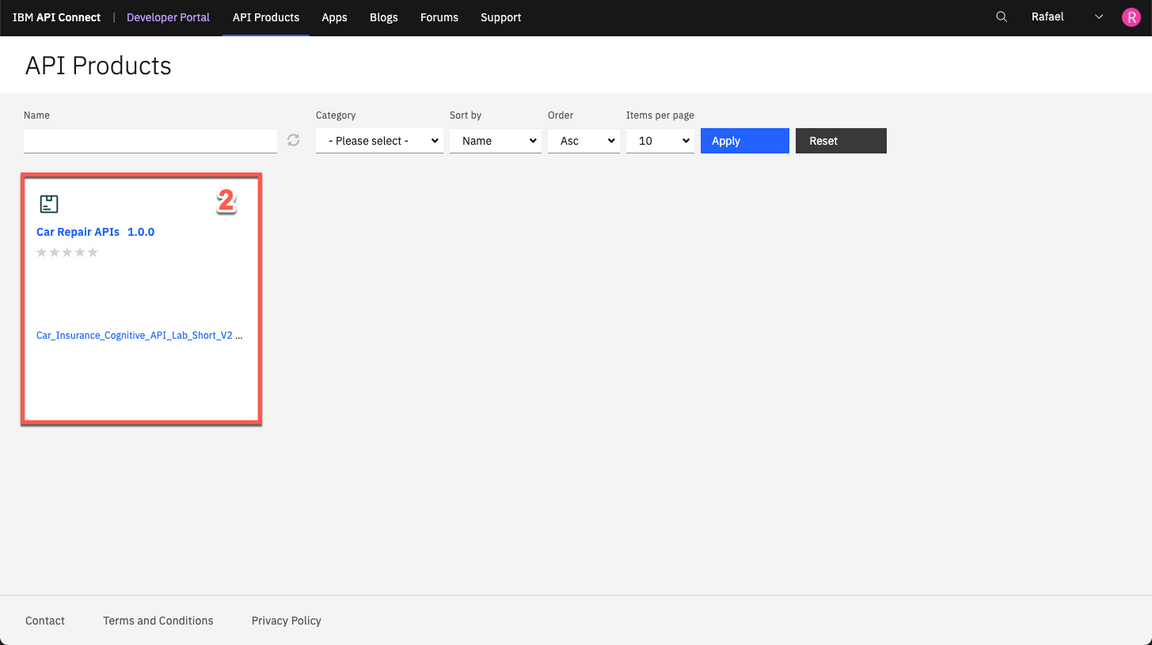
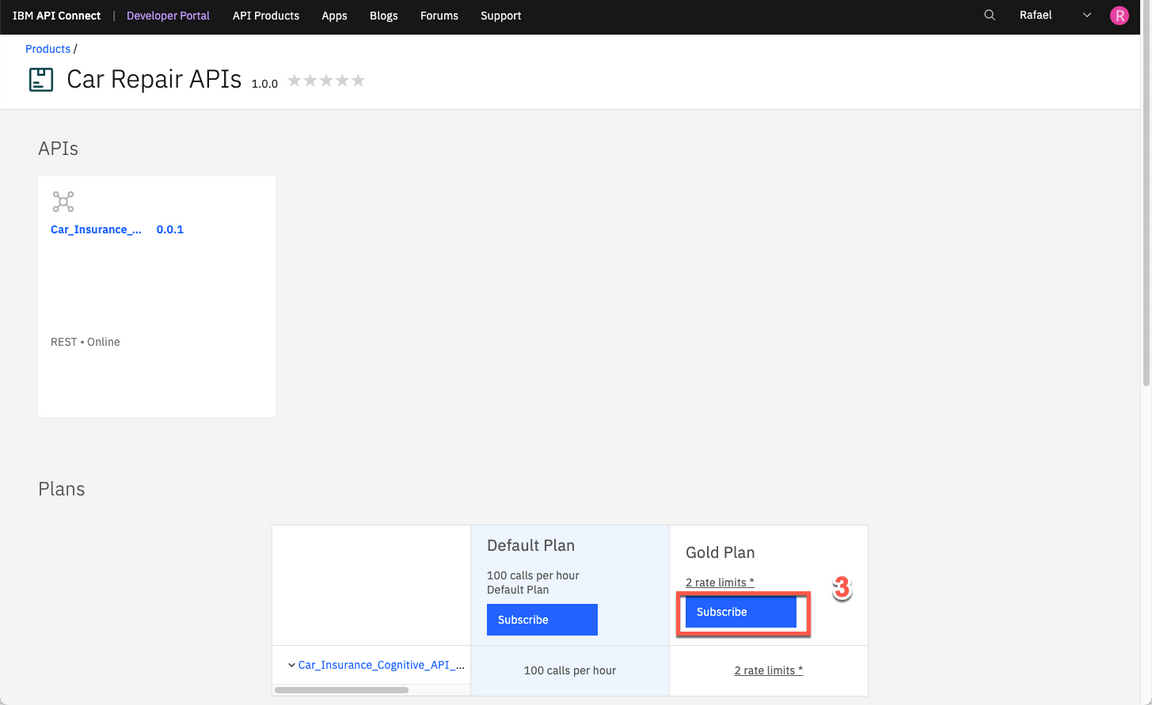
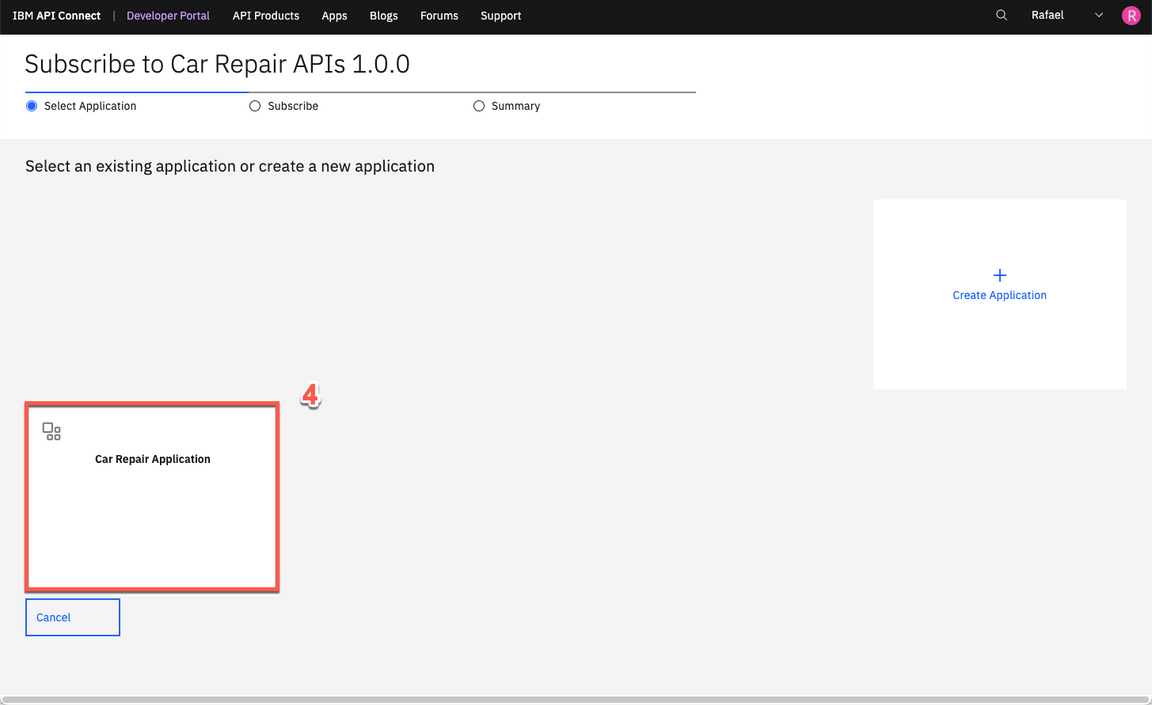
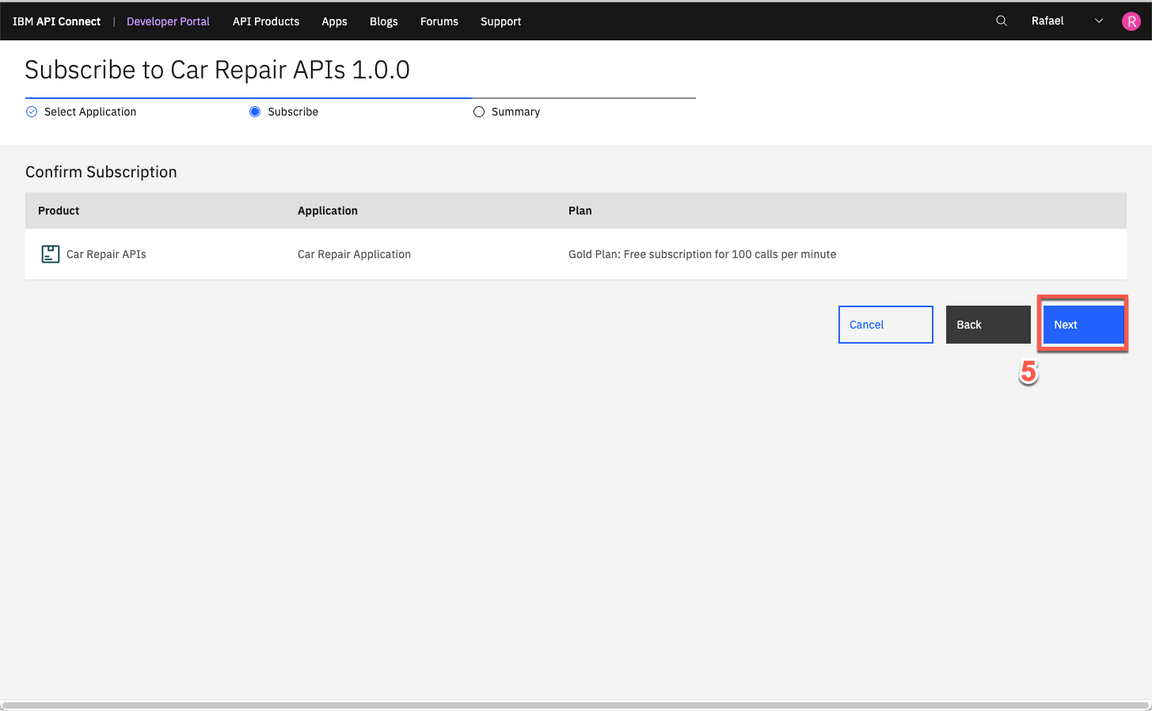
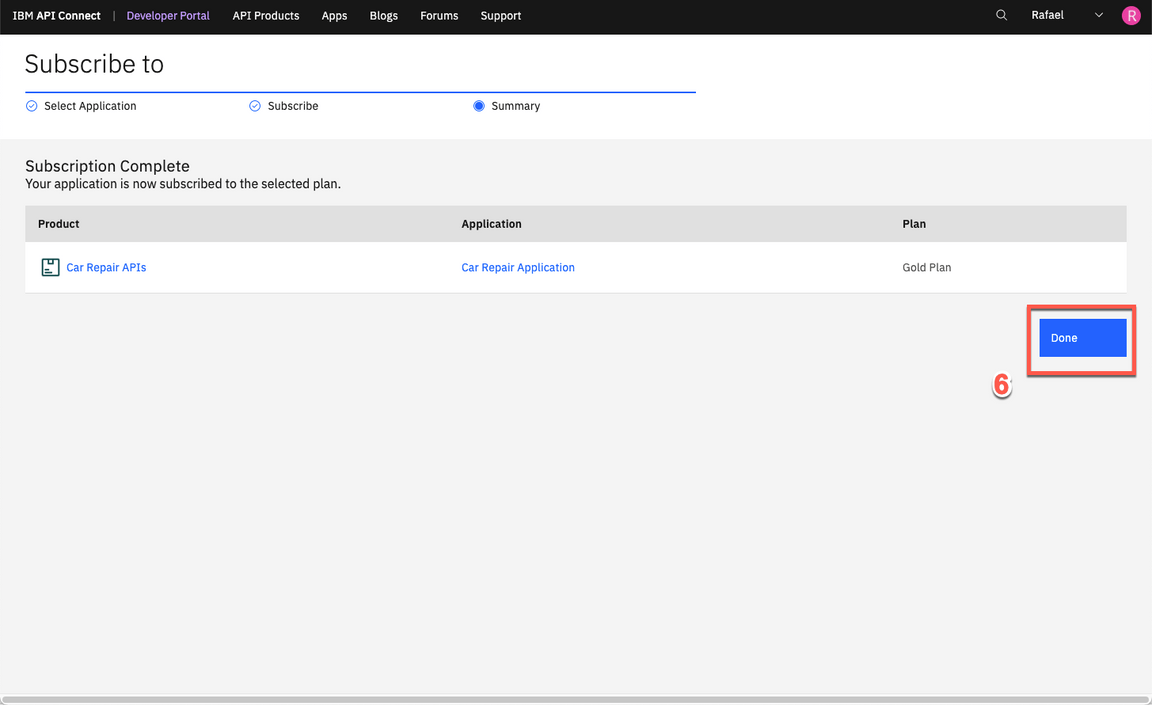
|
4.4 - Test API
| Test API | |
|---|
| Actions | Click on the Car_Insurance API itself (1). Copy the Endpoint (2). Open the POST /CarRepairClaim (3). Explore the Example request area (4). Open the Try it tab (5). Click Generate (6). Click Send (7). Explore the Response (8). |
| Talking Points | We’re now back at the product screen. Let’s explore our API here. From the Overview page, we can download the OpenAPI Document and get the API Endpoint. Note the portal has everything you need to call your API, it’s even generated clients in various languages for you to copy/paste into your calling application. You can try the API on the Try it area. Using the Generate button, the portal generates a request with random sample data for you. Now, let’s test it. Great, we got a response, our API is running, and we’ve gone through the gateway to access it. |
| Screenshots |
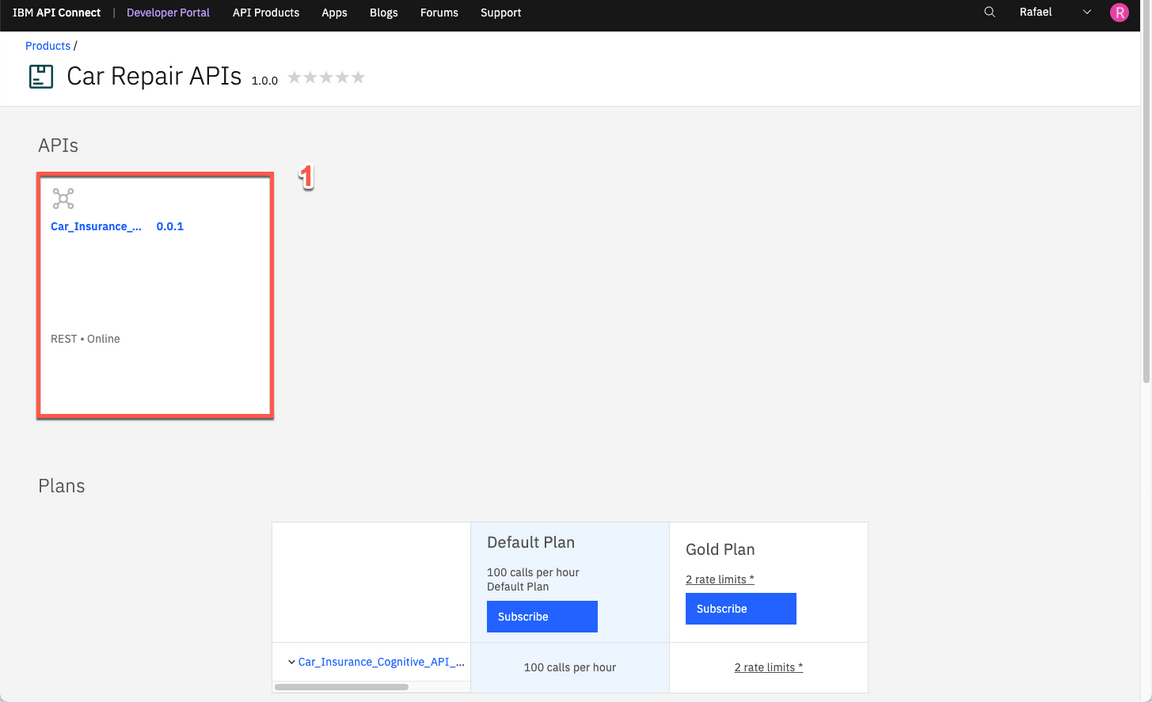
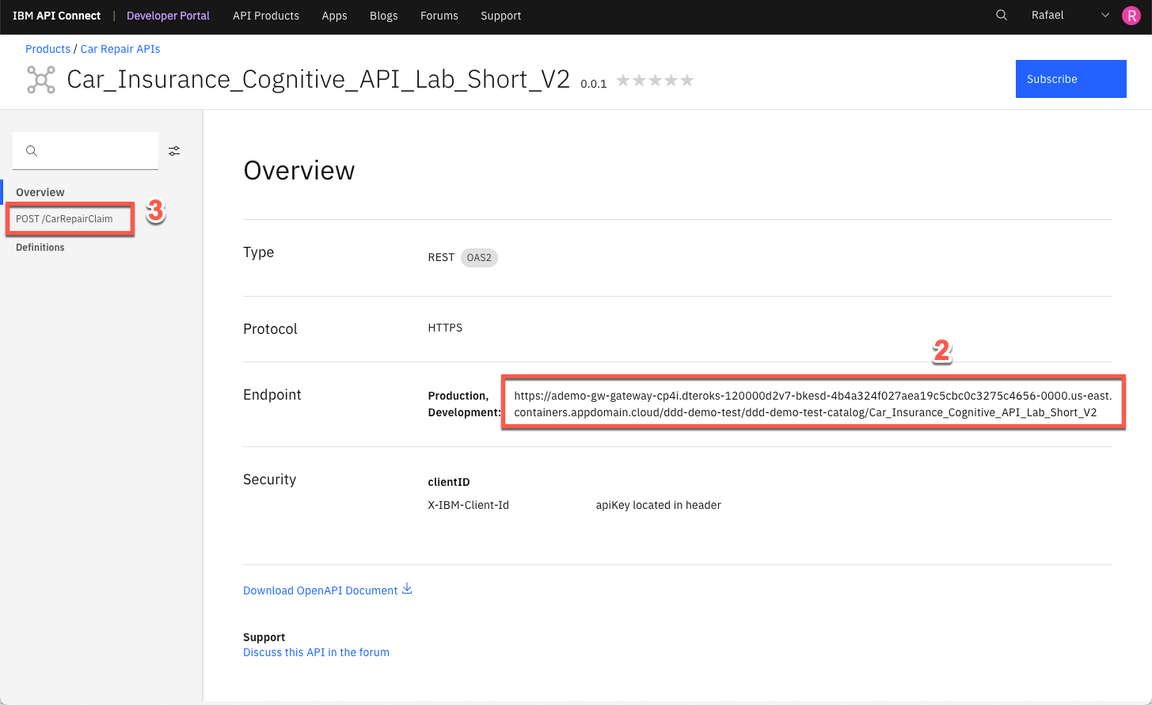
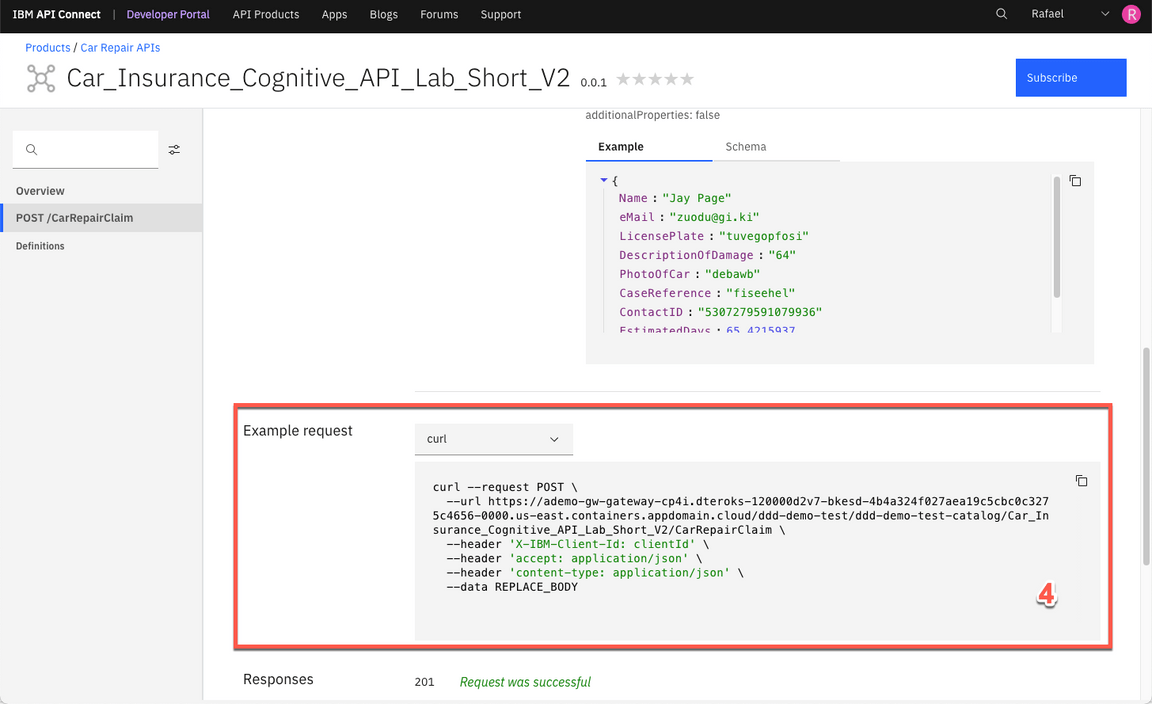



|
4.5 - Viewing the API Statistics
| Viewing the API Statistics | |
|---|
| Actions | Click Apps on top menu (1). Click the Car Repair Application (2). Explore the API stats (3). |
| Talking Points | We can see our API statistics in the Portal. We just need to select our APP, and here we can see all the API calls, including any possible errors. If you make more calls, you’ll see larger statistic results. |
| Screenshots |



|
5.0 - Demo Summary
| Demo Summary | |
|---|
| Actions | Show Demo Final Slides. |
| Talking Points | Let’s summarize what we’ve done today. In the demo we:
- Accessed the Cloud Pak for Integration environment and explored the capabilities
- Reviewed the automated customer interactions integration flow
- Managed access to the flow as an API and set up the security and rate limits
- Demonstrated how a developer can use the API Portal to perform self-service consumption of the API
From a business perspective we used APIs and application integrations to automate a series of steps to: obtain and validate input information from a customer with a concern, open a case in Salesforce, attach the incoming information to the case, analyze the tone of the situation, and respond to the customer with the case number and expected date for resolution.
The customer expressing a concern or needing assistance obtains rapid response to their interaction and the confidence that your business is handling their request. |
| Screenshots |
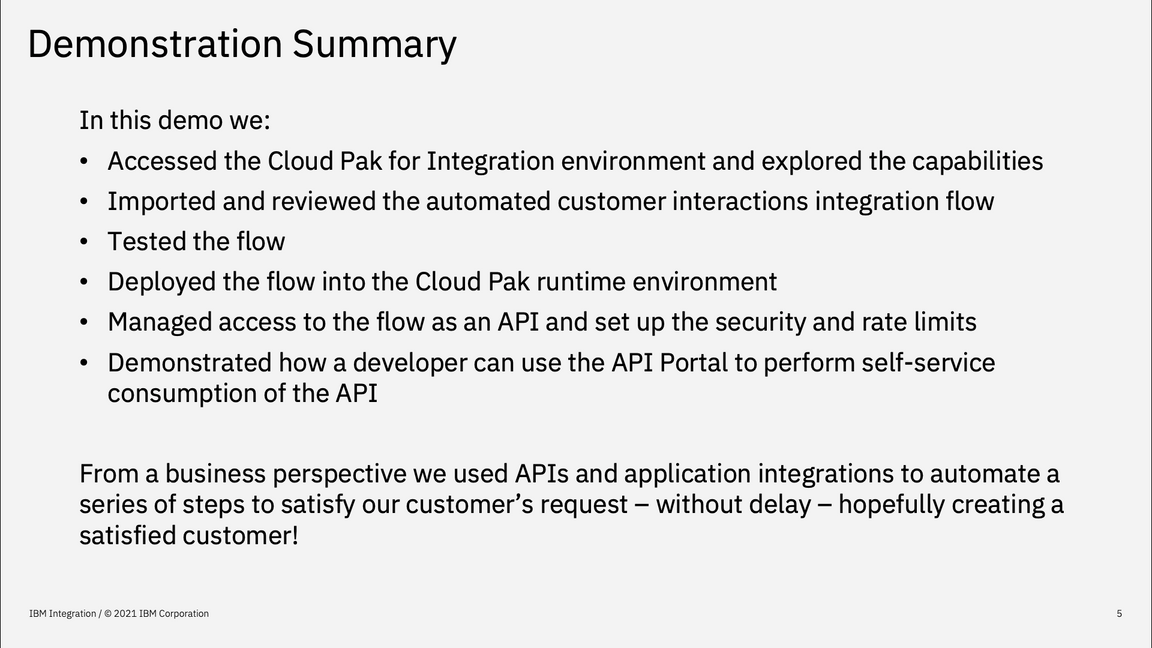
|






























































